Get monthly coaching and support to FINALLY gain momentum in your business without burning out in the process. 🦄 Learn more about WAIM Unlimited.




What we can guarantee you, however, is that this article will help you put anti-burnout guardrails in place and assist you in the creation of a solid foundation for your business that is best FOR YOU and YOUR specific situation.
We want to share with you how we’ve learned to avoid burnout in our two businesses (Teachery + WAIM).
The goal of this article is to help you take actionable steps to avoid that dreaded moment when everything feels like too much and you have to take an extended break from your biz.
In this part, you get to define your enough number (and MMM number if you don’t know it). We’ll explain below what both “enough” and “MMM” numbers mean. We also recommend avoiding listening to the overnight success advice and turning your months-long timelines into years-long timelines. We believe that patience is an important part of the anti-burnout process. Embrace the idea that slow-and-steady is better than fast-and-leading-to-a-mental-breakdown.
In part two, we identify the business model that’s right for YOU (and not just one you followed because of someone else’s story). We also start acknowledging that you will have to eat a few “shit sandwiches” (more on this later). We’ll share why using an experimenter’s mindset is helpful for weathering the inevitable tough moments and we want you to give yourself permission to pivot to a different business model if things aren’t working.
In the 3rd part of this article, we tackle setting your daily work hour boundaries. We talk about drawing your lines in the sand (days you don’t do calls, your response times, how to contact you, etc) and creating an inspiring and motivating workspace tailored for the way YOU work. In doing this, you get to define how you best work and build good habits for finding “flow.” Additionally, we encourage you to put intentional breaks on your calendar like daily walks, days off [GASP!], content breaks, etc.
In this final part, we acknowledge that you will burn out (or burn out again). We hope you will come to accept that WE ALL EXPERIENCE BURNOUT ❤️. We’ll finish up by talking about building your burnout savings, not allowing burnout to affect your self-worth, and defining what you need if you’re currently burned out.
Without further ado, let’s dive into the first part…
The first key step to avoiding burnout starts with goal-setting. You may already be aware of why goal-setting is important but if you’ve run into burnout many times, it might be time to switch up your goal-setting approach.
1️⃣ Not setting any goals can keep you constantly striving for more. If you don’t set any goals at all, your brain will likely fill in the gap with its familiar fallback setting: MORE. Your mind will tell you to do more, grow more, hire more, create more, and work more, without ever really asking itself what all that more is in the pursuit of. That’s a recipe for burnout, please ask us how we know 👩🏻🦰👨🏻🦲😬.

When we don’t set goals our eyes are bigger than we’re capable of handling.
2️⃣ Huge goals with short timelines are a recipe for disaster. If you do happen to set goals, but the scale is too big in too rushed of a timeline (i.e. every “how to make $100,000* in 30 days” YouTube headline!), that is ALSO a recipe for burnout.
🙋 *Please raise your hand if you’ve bought into these lofty promises only to realize it’s A) completely unrealistic and B) totally unsustainable for YOUR life.
Creating a realistic timeframe to hit your (enough) goals is THE most important way you can avoid burning out with your business.
What we mean by “enough goals” are goals that begin with you asking yourself this question:
Your enough goals will be different from anyone else’s, but that’s a good thing! Not everyone needs to run a $100k/year business, or needs to do 5/6-figure launches, or needs to build a team, etc. Instead, it’s about defining what would be enough for YOU, individually, to live a good and satisfying life. That’s why all those folks promising you wild success in short amount of time are only going to lead you to burning out, because they’re likely pointing you in a direction toward a goal that’s supposed to be one-size-fits-all, not one that’s tailor-made FOR YOU.
An enough number for your business is an amount of money generated by your business every month/year that would accomplish all your personal goals, but that wouldn’t require you to burn out trying to achieve it.
But how do you begin to identify your enough number? A good place to start is by defining what we call your Monthly Minimum Magic (MMM) number. This number is your baseline expenses—just the things you absolutely need for each month. It’s the amount of money you need your business to make in order to basically break even. If you’ve never set an MMM number, we would highly recommend doing it right now. Your MMM number should include:
Think of your MMM number as the LEAST amount of money you could possibly live on each month, without feeling like you have to eat Ramen noodles at every meal!
Then, with your MMM number known, tack on (realistic) extra things that would bring you to that level of feeling really satisfied and secure in your life. It could be:
Your MMM number + realistic extras = YOUR enough number
What you’ll find (we’ve seen this over and over again since we’ve been talking about and teaching folks to define enough) is that your specific enough number is less than you may think, and it’s probably also less than that arbitrary number you’ve been striving for in the past! Your previous self has been following someone else’s number, not defining what amount of money would be considered enough for YOU.
Now that you know what number you’re aiming for, we can figure out how long it’s going to take to achieve that specific (for you!) goal.
The online business world is far too saturated with messages about “building your business overnight” and “hitting $10k months in just a few weeks” and “creating a 6-figure business by following a few simple steps.” To be 100% honest with you, all of that messaging is garbage #sorrynotsorry.

What we should all do with “build your biz overnight” promises.
The truth is, to succeed with your online business, it is going to take WAYYYYYY more time than you probably hope/want. Coming to terms with this fact should actually feel empowering because you can take the pressure off yourself and your business a bit. If you simply embrace and understand that you’re in this for the long haul, you can avoid the trappings of working 12+ hour days, weekends, and still feeling like you’re not achieving your goals at the pace you’re supposed to.
Instead of seeing a small, finite, jam-packed schedule ahead of you (that will cause you to burn out), what if you zoomed the lens out a bit and gave yourself a realistic timeline that feels spacious instead of angst-filled? If you did that, you may find yourself less focused on the short-term, immediate result and more focused on making sure the journey feels good along the way. (You can see how extending your timeline helps stave off burnout.)
Patience and business go hand-in-hand, it’s just that no one will try to sell you an online course about being more patient because no one would buy that course. However, and we saw this ourselves when we built Wandering Aimfully, planning ahead to prioritize patience in your business approach will get you through the inevitable tough patches.
👉 Patience will help you overcome the revenue dips and lackluster launches.
👉 Patience will reassure you when the social media algorithms change.
👉 Patience will calm your brain when a successful marketing effort stops working or when a sales funnel that was working goes kaput.
The ultimate irony of anyone telling you that you can succeed overnight, in the next 30 days, etc, is that you are likely in pursuit of EVENTUALLY having a calm and profitable business. Yet, the stress and work you’d have to put in (that 99.9% of the time won’t actually get you there) to see results on this hyper-speed timeline will take your life and stress levels in the opposite direction of calm and profitable.
That’s why a 3-6 year plan to reach your enough number is the crucial first step in our anti-burnout business plan. It’s time to stop buying into the idea that you can fast-track success just because someone sells you on a new way to skip all the hard work. Hard work is where success comes from, but with proper (enough) goal-setting, timeline planning, and patience, building your business doesn’t have to be an arduous, frustrating process.
We’re happy to be riding the (slower) anti-burnout business train 🚂 and we’d love for you to join us!
Here’s what Part 1️⃣ of building an anti-burnout business takes:
Building a business of ease and freedom starts with making sure your foundation actually lends itself to… ease and freedom!
No business model is perfect and different business models bring different types of stressors.
If your business is built on a foundation that requires you to stay on an endless content treadmill (like a YouTube sponsorship model, for example) when producing content is especially taxing for you, that’s a recipe for burnout. Or maybe your business model requires you to work 1-and-1 with clients when you don’t do well with other people’s expectations and schedules; that’s also going to lead you to burnout.
You have to find a revenue-generating business model that aligns with what you enjoy doing most AND what you’re best at.
A lot of people choose a business model they think will make them successful (because, maybe someone on YouTube, Instagram, TikTok, or in your email inbox convinced you there was an “easy road to success”). The truth is, no business model is perfect and different business models bring different types of stressors.
Awesome! It’s a very low-barrier-to-entry business model and if you’re a creative person with lots of ideas, this model gives you the freedom to express those ideas. However, you will have to navigate some technology to create and deliver your digital product. Then, as time goes on, you’ll probably need to update that product with new info. Also, other folks may want you to believe that digital products sell passively, but while that CAN happen, the reality is that you will likely find yourself constatntly writing sales emails, sales copy, and tweaking your sales strategy to bring in consistent sales.
The recurring revenue is great with a membership or paid community, and if you love teaching or helping people in scalable way, this model can be great. But the reality is that you will need to show up for your customers on a recurring basis for them to continue to pay you. And, with recurring payments comes the admin work of dealing with failed payments and cancelations.
📌 Related reading: We have an in-depth article if you want to know EVERYTHING we’ve learned about running a paid membership community with our WAIM Unlimited program.)
Those are just two options. There are many other business types and models to explore. The key for you is to understand which one is right for your situation AND to make sure you’re up for all the challenges that any business model will bring (but maybe pick the one with the least challenges to avoid burnout 😘😘).
Elizabeth Gilbert talks about this idea of a “shit sandwich” in her book, Big Magic. What she means by that phrase is: there are going to be parts of any creative process that aren’t particularly enjoyable but that are worth choosing anyway. Your job is to decide which flavor of “shit sandwich” you’re willing to eat aka which sucky parts you’re willing to move through.
The truth is, when it comes to running a business, there are going to be crappy parts that take away from the joyful and awesome stuff. Find the business model or revenue strategy that feels worth it to you, even when you take into consideration the parts that are less than ideal.

An anti-burnout business model means you’re trying to maximize spending time and energy on the good stuff you LOVE and are passionate about. But, you’re also smart enough to acknowledge there will be hard problems to solve and you’re choosing a specific business model because the positives outweigh the negatives.
You won’t know which “shit sandwich” you are willing to eat until you actually try different business models. This isn’t a bad thing. Remember, thankfully it’s a metaphorical sandwich 😆😂.
Sometimes the only way to discover these options aren’t right for you is to experience the burnout that comes with them, which will ultimately allow you to course-correct.
We said it before and we’ll say it again: You WILL probably burnout at some point—and sometimes that’s even the only way to know what shit sandwich ISN’T worth it—but the key is trying to have your burnout be as painless as possible and not like a volcanic eruption.
We’ve said this for years and it’s one of the best mindset shifts we ever made in online business. It IS emotional when you’re creating your own business. You DO feel some attachment to it and it can hurt when things don’t go to plan. But… If you can always think of yourself as a scientist, constantly experimenting your way through product building, content creation, marketing, sales, customer support, etc then it becomes easier to deal with things when they go wrong.
You likely won’t be able to read this article and magically think your way to the business model that’s right for you. Instead, you’ll have to try a few versions of something, fail at a few things, and experiment through different ideas until you feel what’s right. The important part is to check in with yourself at each step of the way to see if what you’re doing is sustainable long-term.

You, as an [experimenting] business person.
When (not if, sorry) something goes wrong in your business, instead of feeling like your self-worth got punched in its gut, you can simply see it as a failed experiment: “Well, that didn’t go to plan, and it sucks, but here’s what I learned and now I’m going to do XYZ to avoid having that happen again.”
Everything… and we mean EVERYTHING is an experiment in online business. The more you can reframe everything that way, the easier the hits are to take when they come your way.
And don’t be afraid to pivot! Maybe you’re running a digital product business and it’s not as passive as you’d hoped. Or maybe you’re thinking of creating a membership to shift to more recurring income? No matter where you are, take it from two people who completely blew up their businesses in 2018 and essentially started from square one. Success won’t happen overnight, but you absolutely can completely change things up and create an anti-burnout business 💪🙅🔥.
Here’s what Part 2️⃣ of building an anti-burnout business takes:
We’ve talked about creating a foundation that is sustainable for you, in this next part, we’re going to focus on your day-to-day actions and how those actions can keep you from over-extending yourself.
One of the quickest ways to ride the bullet train to Burnout Town is by not having firm boundaries. When it comes to the amount of hours you work each day and what things take priority on your to-do list, it’s important to remember (if you work for yourself) that YOU are your own boss!
You make the schedule, you set the priorities each day/week/month, so it’s within your power to make sure you’re not burning the candle at both ends.

Many years ago when Caroline was working with clients doing brand design, she found herself feeling like there were never enough hours in the day and she was always behind schedule. To solve this problem, we sat down in front of her calendar and started by asking the question, “how many hours do you WANT to work?” After some chatting, it was decided that 5 hours of dedicated client work per day was most realistic, and the hours of 10am – 4pm (with an hour break for lunch) were her most productive. From that moment forward, a boundary was put in place for those specific work hours. She started building her client proposals based on these time blocks available on her calendar. And guess what happened? Almost immediately she felt more productive and in control, as she knew when she needed to get into work mode, and then she had a stopping time each day so she wouldn’t overwork herself.
You may have started your business to escape the 9am-5pm schedule, but it IS helpful to have set working hours based on your lifestyle and when you want to fit work into it.
Keep in mind you can also adapt this idea for how you work best. Maybe it’s not the same exact hours each day. Maybe you need something more flexible and adaptable to your energy. The most important part is that you ask yourself the question and set the intention NOT to overwork.
Whether you’re a seasoned pro or you’re just getting started with your biz, now would be the perfect time to sit down and answer these two questions:
Once you have those answers, put that schedule on your calendar the next few weeks and try it out!
To set a “line in the sand” simply means to establish a boundary you’re not willing to cross.
To set a “line in the sand” simply means to establish a boundary you’re not willing to cross. It’s helpful to take some time and ask yourself, “what rules do I want to establish about the way I conduct my business?” These rules can be instrumental in not engaging in behaviors that drain you or lead you to exhaustion.
For example, quite awhile ago, I (Jason 👋) found myself on phone calls, interviews, or having online meetings on Mondays and Fridays. I DREADED THEM. Monday calls killed my beginning of the week momentum and Friday calls interrupted my end-of-week push to tie up loose ends and transition calmly into the weekend. Then, I had a moment of realization: Why am I doing this to myself!?? There’s no rule that says I have to take calls on Mondays or Fridays, so why the heck am I doing that? Pretty soon after that moment, I put a boundary in place to NOT do calls on Mondays or Fridays. If someone reached out and only had those days available, I would kindly say I don’t schedule calls on those two days but am happy to chat Tues-Thurs. There hasn’t been a single time in nearly a decade when I’ve had to break this boundary.
Those of you with clients have most definitely run into the late night email/text/DM where a client has an “urgent” request. But, just because something is urgent for them does NOT mean it has to be urgent for YOU. The way we learned to get around this issue is to put a boundary in place early on where you’re 100% honest about your response time. Two things we’ve done that work really well:
Just because something is urgent for your client or customer does NOT mean it has to be urgent for YOU.
Just because a client asks for your phone number doesn’t mean you need answer their calls or texts! If you want people to communicate with you via email, make it VERY clear what you want them to send to you in email requests (is it screenshots? Loom videos? Etc). Maybe you don’t love email and you want to create a dedicated support inbox using a service like HelpScout or even something simple like a Google Form folks can fill out. And, if you want to offer a support chat/messenger directly on your website (or in your online course), just make sure you’re setting the boundaries for when folks can expect a reply (be VERY clear it’s not “live” support).
All of these boundaries serve to set the expectation for other people about how they can engage with your business in a way that doesn’t feel overly taxing for you. That is one key to being able to continue your work long-term.
We talked a bit about time boundaries, but now let’s talk about physical boundaries.
An often overlooked part of running a business that doesn’t burn you out is having a dedicated workspace that’s separate from your life. Trust us, we’ve tried working from the couch or the dining room table MANY TIMES, but the result of this was that work too easily can bleed over into your life, consuming much of your free time to rest and recharge. Creating a separation will lead you to actually enforce those work hours we spoke about and then when you’re away from your work space, your brain will actually be able to wind down.
Even if you live in a small space, consider a spot for a tiny desk. And, regardless of the size of the desk you can fit in your home, MAKE IT FUN! The more you can enjoy the physical area you sit or stand in to crank out some work, the more restorative and energized your work time will be.

It’s key to experiment with different approaches to productivity until you land on something that allows you to get in that “flow” zone.
👨🏻🦲 For Jason: First thing I want to do is toss on a synthwave ⚡️ or lofi 🎧 playlist. From there, I need to close out of all ancillary applications on my computer and just have the ONE (or two) apps open for whatever task I’m working on. And how do I know what I’m working on? My Google Calendar is chalk-full of time blocks (30, 60, 90 minutes) and I don’t stray from the task at hand.
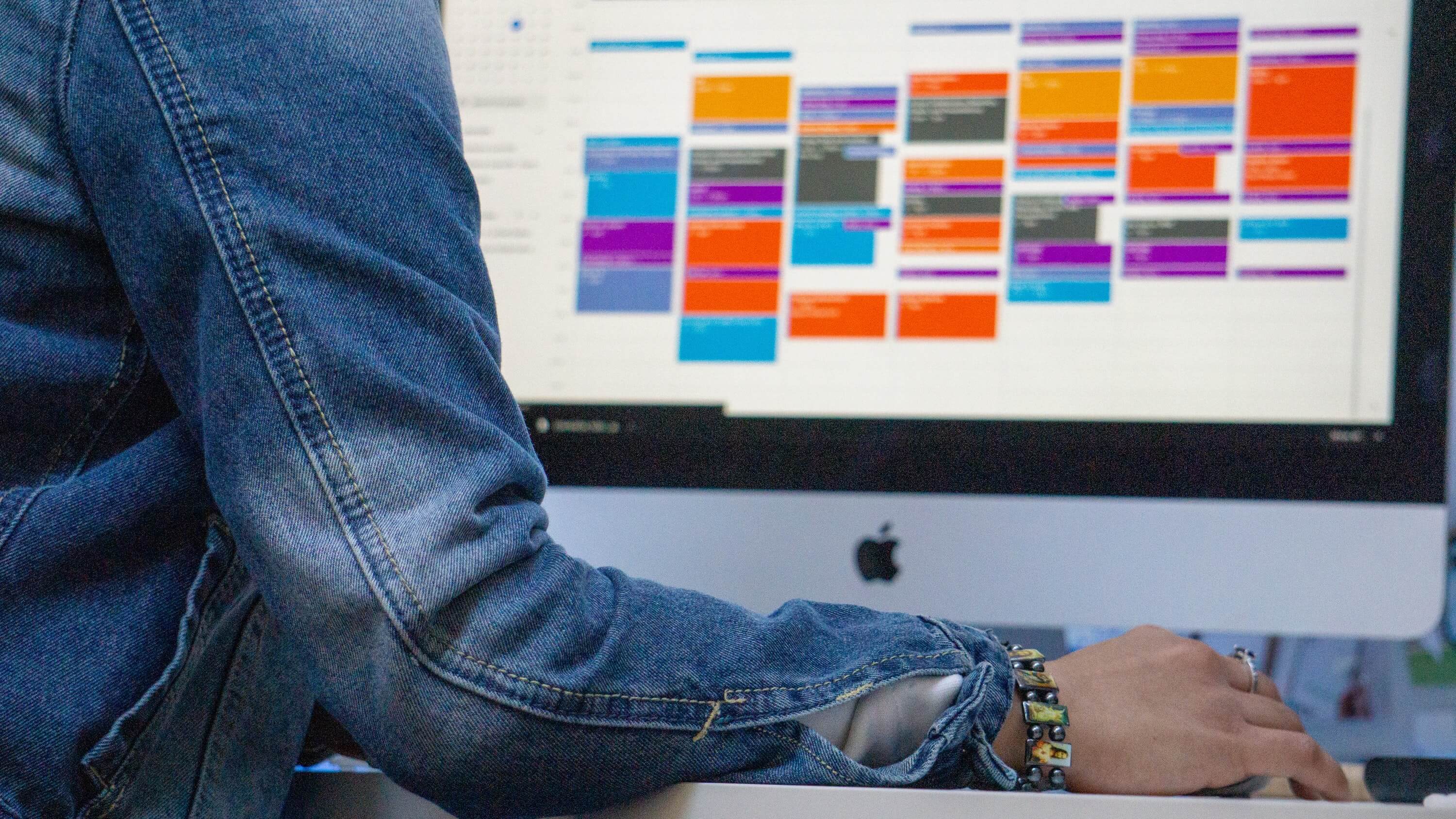
👩🏻🦰 For Caroline: First and foremost I need to know what tasks I intend to complete any given week (I keep track of that with my favorite app Notion.) Then I’ll choose an order for those tasks each day based on where my energy is at. I use the Pomofocus.io app to split up work blocks into pomodoro increments and then I put on a playlist that matched my mood and I go to town. The MOST important part of my work day, though, is that I take intentional breaks—which is our next big tip.
If you’re anything like us, your work can spill over into weekends and holidays, leaving you constantly saying, “I didn’t even know it was Labor Day!?” We’ve found that taking intentional breaks from our work can be super impactful in recharging our batteries, even in small increments.
A small daily break that has always been positively impactful for us is taking a 15-30 minute walk. Whether we end up at a coffee shop, are just circling the block, or are trekking into nature a little bit, a daily walk is a good time to step away from technology and rest our eyes and minds. You might find it hard to carve out this time, but pick something that works well with your schedule! Define this time, put it on your calendar, and be intentional about making it a habit.

We don’t actually take daily walks in slow motion 😅😅
We also take breaks with our content schedule. We intentionally pause our weekly email newsletter every summer so we can recharge those writing batteries and so our readers have the chance to get excited about our content again. We take the occasional month or even months-long break from our What is it all for? podcast too just to give ourselves time and space to feel refreshed. These intentional content breaks are absolutely crucial for staying engaged with our work, but it’s also helpful for keeping your audience on their toes and not letting that connection get stale.
Alrighty, that’ll do it for part three! Let’s get your action steps…
Here’s what Part 3️⃣ of building an anti-burnout business takes:
In this final section, rather than give you one more tip for avoiding burnout, we thought it would be far more practical to talk about the burnout-elephant in the room, which is this: despite following the tips we outlined, you WILL likely burn out anyway. 🙈🙈
Because the burnout threshold is different for everyone, and human instinct is to push the limit until you know what the limit actually is. We call this the “hand on the stove” moment, or that moment of pain you have to experience yourself before you know just how badly you want to avoid it in the future.
We want to offer you some tips for when burnout happens. How to soften the blow, how to be kind to yourself, and how to apply that lesson to the future.
Ripping the bandaid right off, let’s just be 100% truthful and honest: Burnout may not be “normal” (meaning working ourselves into the ground is not healthy) but it is COMMON. It happens to so many entrepreneurs—including us! If you find yourself hitting a wall with your work, it’s important to know there’s nothing wrong with you. It’s a predictable part of the entrepreneurial journey.
Sometimes we hit burnout because we put too much on our plates, or life overwhelms us, or we bite off more than we can (business) chew, or we just run into a string of bad luck.

Even though it’s common, that still doesn’t mean it’s fun, though! It sucks, and it’s hard to get through. But, on the bright side, the burnout experience can often be a solid life/business lesson that will make us stronger and help us avoid bigger problems in the future.
Having this mindset of acceptance towards burnout when it comes can help you bounce back with confidence (in time) and avoid any kind of shame or guilt you may experience when it arises.
Having a mindset of acceptance toward burnout can help you bounce back with confidence and avoid any shame or guilt you might experience.
Once you accept burning out is a part of the journey, the question becomes how are you going to handle it when it arises?
Whether you’re currently experiencing burnout, are on the cusp of burning out, or are in a good place and just want to know how you should handle it in the future, the best piece of advice we can give you is this: give yourself TIME to recover from burnout ⏳⏳⏳.
As much as we’d love to tell you there’s a simple 3-step process to overcoming burnout, what we’ve learned over the years (and many burnouts) is that TIME is the only healer. Taking a break, stepping aside, completely removing yourself from the work that led you to burnout is the answer. And while that’s easy to type out in a sentence, we know from lots of experience how challenging that is!
Those are all great questions and they all come with answers that are different for everyone. We can’t guarantee our advice will be perfect, but we can tell you what’s worked for us:
It could be dipping into your savings. It’s why you save, after all—for one of those rainy days (and with burnout, there’s a 100% chance of [metaphorical] rain on the forecast). If you don’t have savings, it boils down to figuring out what you can do for money that can sustain you. Is it selling stuff around your house? Is it asking a friend to hire you for low-pressure contract work? Is it moving back home to build back up with less overhead? All of these options are on the table and none should be ignored.
Honestly… your goals get put on hold when you’re burned out. There’s NO sense in trying to continue to push forward or make progress, you must rest and you must be okay with the fact that the pause button is your only button. In these situations, it’s important to remember you’re taking one step back to ultimately take two steps forward. In that regard, you ARE still working toward your goals, you’re just making sure you’re in a healthy, energized head space in order to go after what you want.
This one is sooooo difficult because when you work for yourself it’s incredibly hard to separate your work from your worth. The best advice we can give you is to repeatedly remind yourself that your work is not tied to your identity. Your work is a set of experiments in a scientific lab of sorts. As soon as you leave that lab (your work), you are your own person with a separate identity. What happens in Vegas the lab stays in the lab!
It’s really hard to hear, but again, TIME is the only answer to overcoming burnout.
Allow yourself a break, and do whatever you must to survive and get by in the meantime, because the harder you push against burnout, the longer it will take to overcome (and the more damage you may be doing in the process.)
Okay, let’s say you’ve burned out, you’ve given yourself time to recover, and you’re feeling good again… now how the heck do you avoid burning out again!??
Well first, read the previous parts of this article 😘. The second thing to learn from your last bout of burnout is to understand what may have gotten you there. Then, put up some strong guardrails to help you avoid falling off the burnout cliff in the future.
Only you are going to know what guardrails are most important for you, and it’s important you don’t ignore the mistakes of your past.
Only you are going to know what guardrails are most important for you, and it’s important you don’t ignore the mistakes of your past. We’ve certainly experienced burnout multiple times for the same reasons, and it’s not like you’re going to fix things perfectly after burnout, but you should absolutely try!
The last part of avoiding burnout is being able to recognize when you’re pouring your energy into a business tactic that isn’t sustainable.
This is especially dangerous when a shiny new opportunity comes along and you feel pressure to a) take advantage of a marketing channel that can get you disproportionately high organic reach or b) hop on the bandwagon because you see other business owners doing it.

It’s easy to get caught up in trends, especially when your previous efforts may not have worked well, and then something new clicks and you start to see a lot of momentum. You want to ride that bullet train toward your goals and hold on for dear life! But, if you go too hard and invest too much time and energy in something new, all your foundational things can easily get left behind (goals, processes, boundaries, healthy habits, basic biz stuff, etc).
We’ve been there: The new thing emerges, you start to feel a positive change in your business, and you want to do everything in your power to grab ahold of that bucking bronco and soak up as much growth as you possibly can. However, if something new is taking up all your precious resources, something is going to have to give in its place. That’s when you typically end up burning out, even if you’re generating the most revenue, the most audience growth, and the most notoriety you’ve ever had.
We DO want you to enjoy the success those things bring! But, we also want you to remember you are trying to build an Anti-Burnout Business and to have something that sustains you for the long-term, not just a flash in the pan.
When it comes to shiny new burnout, just keep in mind your processes and your goals. You may need to reconfigure both of those things and you may need to reprioritize what really matters, but that’s the key: Embrace the new awesome thing, but be intentional with how all of that time and effort fits into your existing day-to-day.
Here’s what Part 4️⃣ of building an anti-burnout business takes:
Here are all nineteen tips we shared in this article to help you avoid burnout in the future and build an Anti-Burnout Business 🙅🔥:
1. Define your enough number (and MMM number if you don’t know it)
2. Stop listening to the overnight success advice
3. Zoom the lens out and turn your months-long timelines into years-long timelines
4. See patience as an important part of the anti-burnout process
5. Embrace the idea that slow-and-steady is better than fast-and-leading-to-a-mental-breakdown
6. Identifying a business model that’s right for YOU (and not just one you followed because of someone else’s story)
7. Acknowledging that you will have to eat a few “shit sandwiches”
8. Using an experimenter’s mindset to better weather the inevitable tough moments
9. Giving yourself permission to pivot to a different business model if things aren’t working
10. Set your daily work hour boundaries
11. Draw your lines in the sand (days you don’t do calls, your response times, how to contact you, etc)
12. Create an inspiring and motivating workspace
13. Define how you best work and build good habits for finding “flow”
14. Put intentional breaks on your calendar (daily walks, days off, content breaks, etc)
15. Acknowledge that you will burnout (or burnout again)
16. Accept that WE ALL EXPERIENCE BURNOUT ❤️
17. Start building your burnout savings now (and/or create a plan)
18. Decide what guardrails you need if you’re currently burned out
19. Be prepared for the new shiny object burnout
We hope that you are able to take actionable steps to avoid burnout from this article. As a reminder, reading an article does not promise you’ll never burn out again. But what we can guarantee is that you now have the knowledge to help you put anti-burnout guardrails in place and assist you in the creation of a solid foundation for your business that is best FOR YOU and YOUR specific situation!
While we love productivity, we’re NOT trying to be the most productive humans ever and we don’t enjoy hustle-culture. However, we are constantly trying to improve our efficiency and use systems that make our lives easier.
When wearing multiple hats in your online business, it becomes all too easy for tasks, projects, and goals to fall through the cracks.
As creative people, we don’t always think about organization first, but organization has actually made us MORE creative.
When you can get all of your to-dos, your tasks, the overwhelm of everything you have to think about out of your brain and into a system, it leaves more room for creativity, for having ideas and for executing those ideas.
When you can get all of your to-dos, your tasks, the overwhelm of everything you have to think about out of your brain and into a system, it leaves more room for creativity, for having ideas and for executing those ideas.
Let us share a big, juicy secret with you: Sustainable habits and being consistent are the most* important things necessary when trying to reach your goals.
*When we say most important, we mean the most important things YOU can control. We don’t want to ignore or minimize that privilege is real and not everyone has the same advantages.
But alas, forming new habits can be a struggle!
We all love to read/watch/listen to other people talk about their holy grail productivity tools and habit-building hacks, but it’s important that you figure out what works best for YOU and your unique situation.
Here’s the truth about our journey with organizing our business and staying on top of things using different productivity tools/tactics over the years…

Every time we discover a new productivity tool or app, our motivation and organization shoot up! We get really excited and we spend hours setting up a new app to ensure maximum productivity but then, a few months (maybe even weeks) later, the adrenaline of the new shiny app wears off and we just stop using it. #wompwomp
It happened with Trello.
It happened with Asana.
It happened with digital planning.
It happened with Airtable.
We craved consistency in our organization systems. We wanted a system that was flexible enough that we could adjust when we got bored (or didn’t feel as productive). We also wanted something versatile enough to manage multiple types of organization so we could focus on actually using just ONE system, not three different apps and systems.
Notion is what finally fit that criteria.
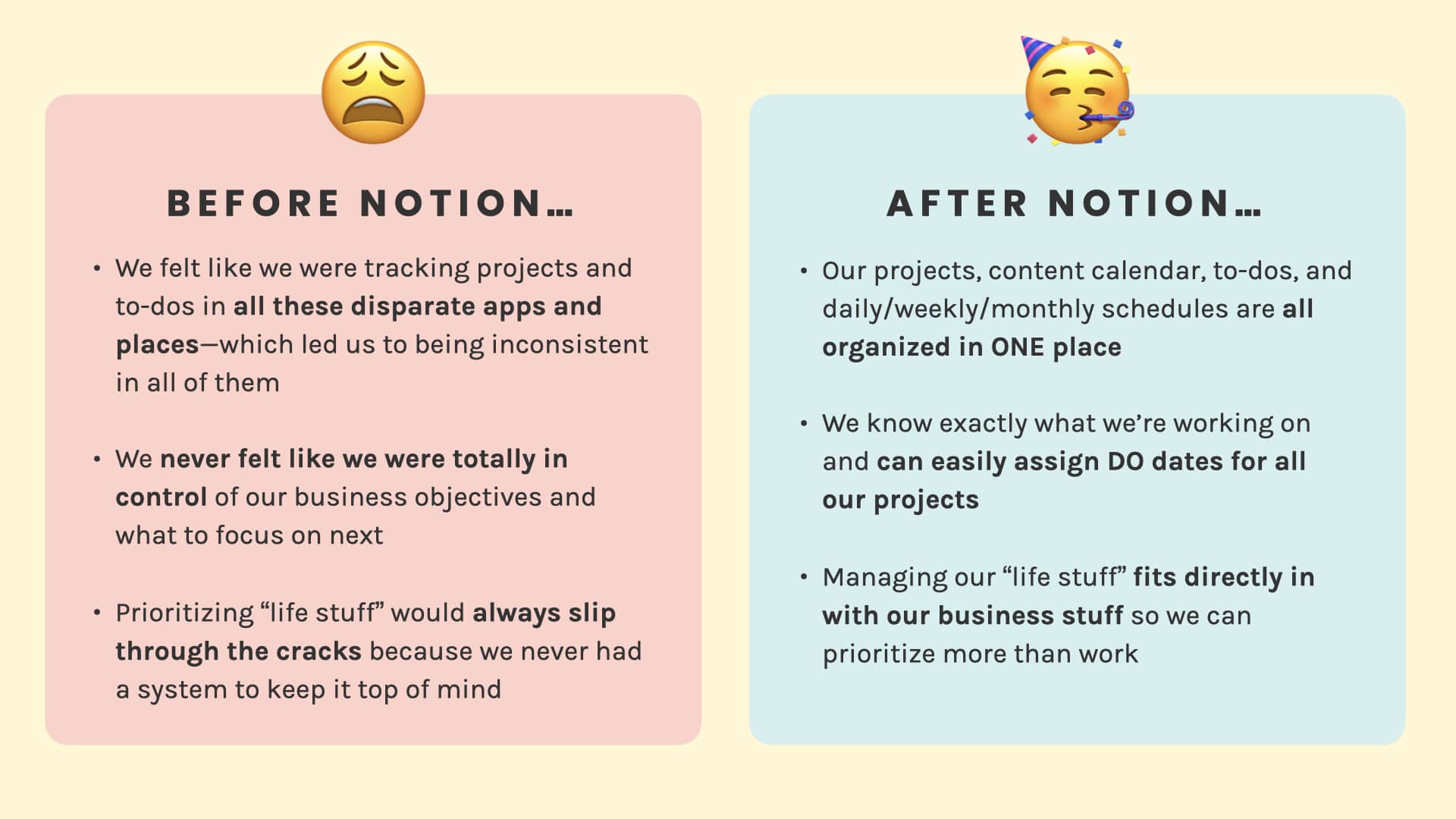
Before we dive into how we use Notion to organize our lives and businesses, let’s go through a little crash course on the basics of how Notion works.
Notion is a system of interconnected pages. You can add content to each page by using different types of content blocks.

There are many different content blocks in Notion such as:
We like to think of Notion as a system of blocks for you to build whatever you want.
You can pick and choose the blocks that would work for every single page in your Notion workspace.
But by far, the feature that stands out the most is the ability to create Databases.
Notion Databases allow you to organize similar pages and assign different properties to them.
While databases seemed complicated and clunky with other productivity apps, Notion has really nailed this feature!
You can visualize the same Database in different ways using Views (Gallery, Calendar, Board, Timeline, etc):

You can also create Templates to load a pre-made set of content blocks for every page.
The best part of Notion is using all these blocks together to build whatever dashboards and pages are most helpful to keep your life and business organized. Truly, the possibilities are endless and that’s what makes Notion powerful!
Note: This section is a very abridged overview of Notion and all its functionalities. Notion has very robust and easy-to-understand help docs so if you want to deep dive into a specific feature, you can go to their help docs to learn more about it.
After many months of using Notion, we took a look at the MOST important databases and pages we use here at Wandering Aimfully and then we organized it into a system we could teach to you!
And that system has an acronym, because DUH.
🦅🦅🦅 (feel free to do your own bird screech sound effects for added flare!)

The remainder of this article will be less about the ins and outs of how to set up the S.O.A.R. Notion system, and more about how we USE the system to run our lives and businesses more efficiently and calmly. Our S.O.A.R. System template is only available to our paying Wandering Aimfully members. Hopefully, you’ll be able to create your own system from what you learn based on our setup!
Before we dive into each component of the system, we’re going to give you an overview of the key pages in our S.O.A.R. Notion system. This will give you a reference point for everything in the system, then we’ll show you how we actually USE it.
The pages in this category are the foundation blocks of setting the vision for what we are aiming for, what areas of growth we want to see, and what projects will help us get there.
We have three main databases for the Setup part of the system:
In this database, we’ve listed out all of the areas in our life that we want to pay attention to. Think of broad categories like Family, Finances, and Knowledge and Learning. Here are the exact Life Area categories we use:
In order to cultivate each Life Area, we’ve created a relation property that is linked to the Goal Tracker database (more on this below) so we can set goals for each area of our life.

For example, in the Finances life area, we set a goal to get 20 sales of an online course during launch.
💡 Tip: One of the ways we also like to use the Life Areas database is by rating it on a weekly basis (during our Weekly Reviews, more on this in Part 4) using a scale from 1 to 10 based on the attention it got during that week. Afterwards, we sort it from highest to lowest, we can clearly see which Life Areas we could be cultivating more or we can decide what our current priorities are.
In this database, we add each goal as a Key Result (specific, measurable outcome) and identify the Objective (more intangible and broad) that it aligns with.
Each goal is connected to a Life Area and to Projects (if applicable) using relation properties. We also have a date property to take note of when we want the goal to be completed.
![]()
For example, the key result is to write & publish 5 new articles, and the objective it’s trying to serve is to increase organic website traffic. This key result is connected to the Work Productivity life area and the Blog project.
This database consists of any projects that we want to track for our business(es). This could range from launching a new course, tracking an ongoing marketing channel like Podcasts, to managing your Clients, etc.
We find it really helpful to create Projects for content creation as it’s easy to have those recurring “projects” slip through the cracks week by week if you don’t plan them accordingly with everything else.
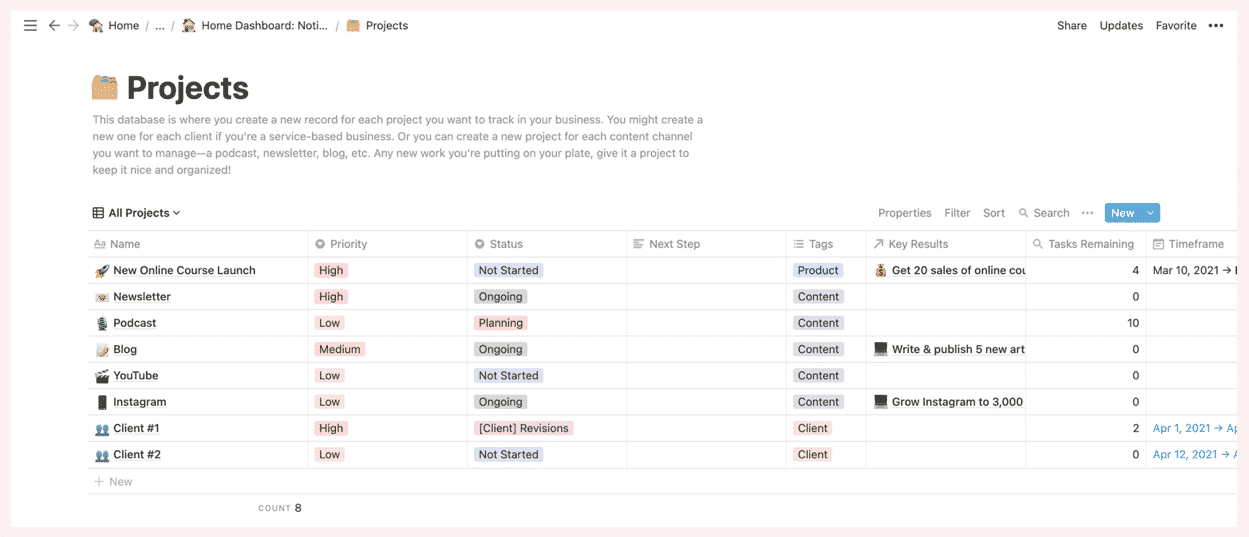
The PAGE area of each project is where you can manage everything related to just that project. We’ve created a Project Template where we set objectives and key results for the project. We also create the tasks associated with the project and compile the resources and inspiration for it.

Just to further clarify how these all work together, we like to think of it as:
Here’s a specific example:
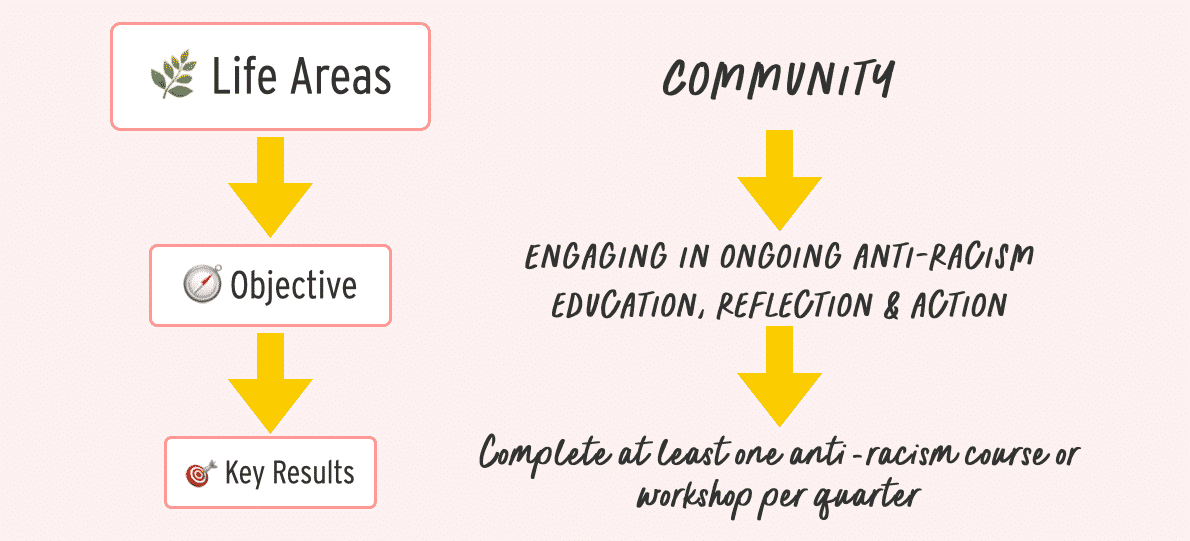
You can also apply the same concept to your Projects. For example:

The pages in this category are the smaller bits that projects and initiatives get broken into. These pages help us move the bigger projects forward.
We have three main databases for the Organize part of the system: Tasks, Content Calendar, and Social Posts.
All of our tasks across all of our Life Areas and Projects go into this master Task Manager database.
For each task, we assign a DO Date which is the date we plan to actually work on the task, not the deadline.
Quick shout-out to August Bradley; we believe he came up with the term “DO Date” for his own Notion system.
We also connect each task to the Project or Content Piece (more on this later) the task is related to via relation properties.
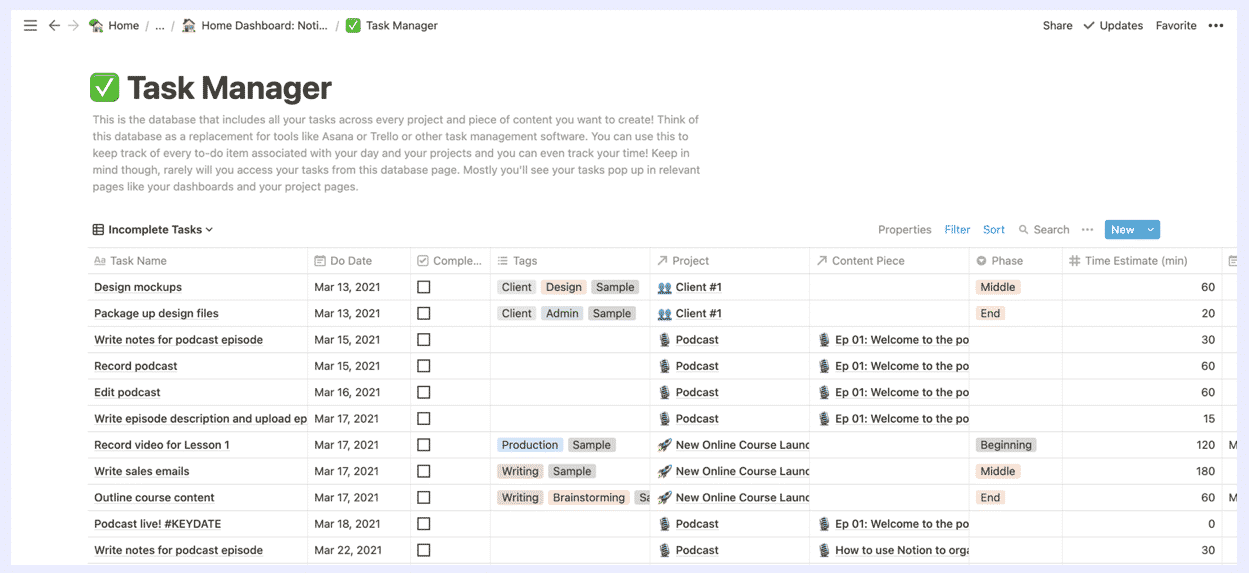
For example, the task record podcast falls into the Podcast project and the Episode 01 content piece. That way, we’re able to see all the tasks in the context of the project or specific content it falls under.
💡 Tip: You can also estimate how long your tasks take and then log a Start Time and End Time (using two date properties) to see how long each task actually takes. If you’re diligent about tracking your time for each task, it’ll be easier to estimate times for similar tasks in the future.
All of our content (articles, podcasts, newsletters, YouTube videos) goes into one master Content Calendar database.
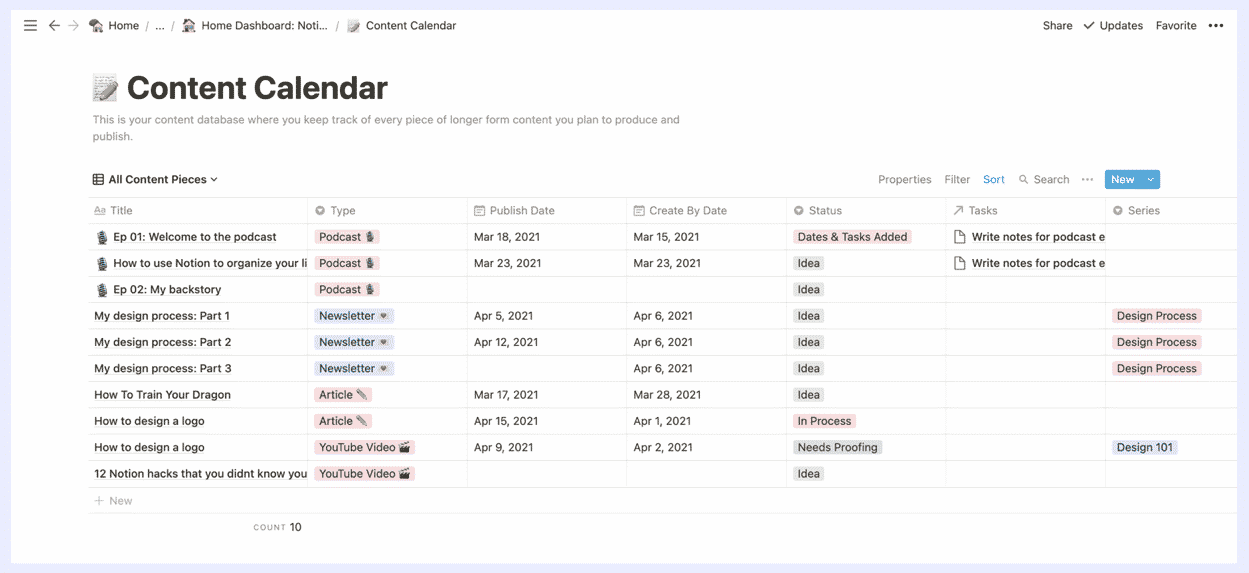
We use the type property to differentiate between the different content channels and to set the status of each content piece. We also add a Publish By date (deadline) and a Create By date (when the majority of the creation will happen) to each content piece.
The Social Posts database functions similarly to the Content Calendar but we prefer to keep it separate because if you’re posting on your socials every day, it can get cluttered very quickly.
We use the type property to differentiate between the different platforms and to set the status of each social post.
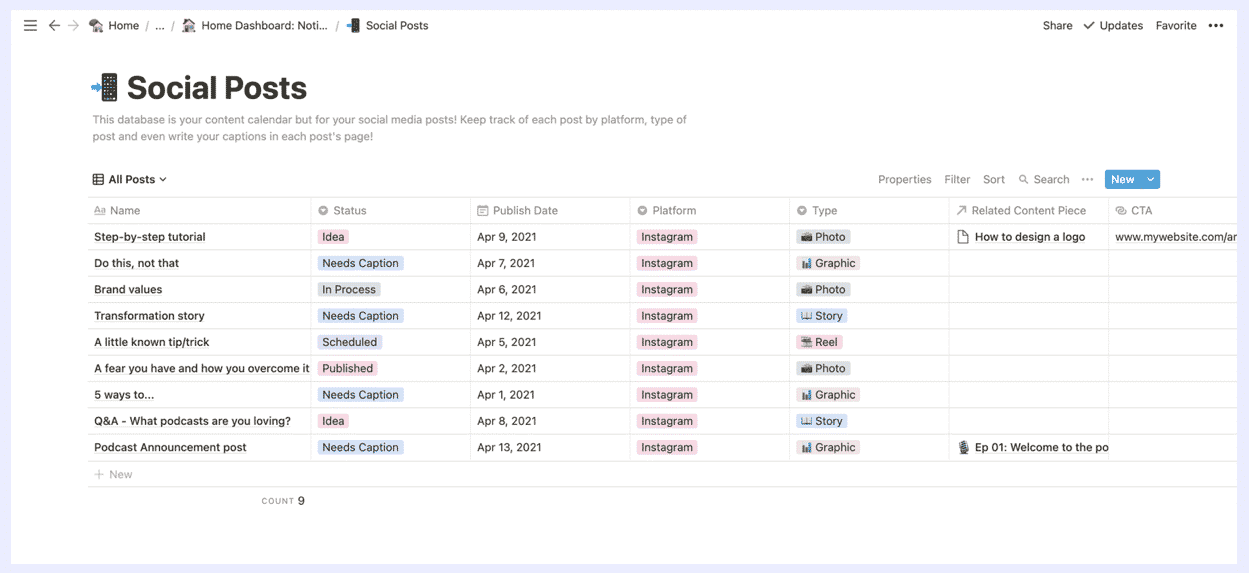
The Calendar View for both the Content Calendar and Social Posts databases are especially helpful to see when our content and when the related social posts get published.
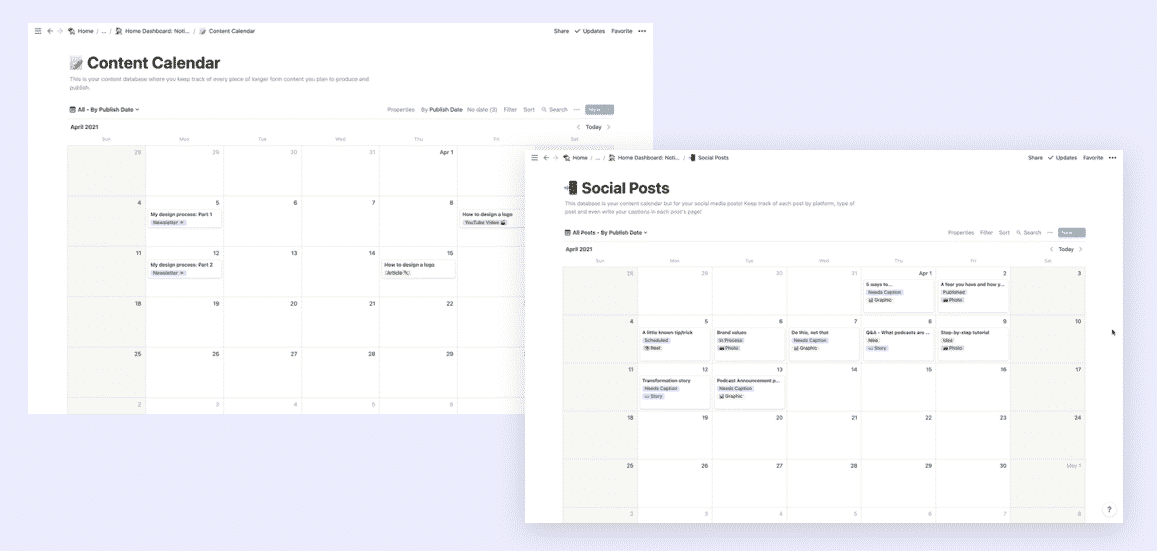
The pages in this category are the dashboards and pages designed to actually GET. THINGS. DONE. most efficiently.
We have three main pages for the Act part of the system:
This is really where the system starts to come together because this is where you execute on all of the stuff that you did in the set-up and organize sections.
This page is where we spend most of our time in Notion every single day.
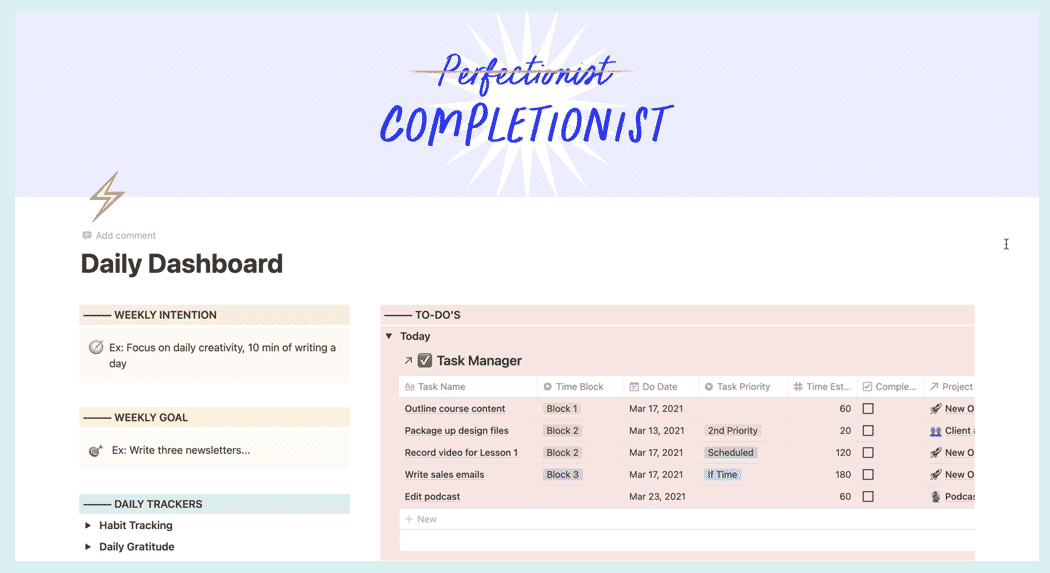
You can customize your own daily dashboard but for our system, we have spaces for:
The most actionable part of the Daily Dashboard (and where the magic really happens) is the Daily Task Manager. This is the same database as your Task Manager but it is filtered to show only the uncompleted tasks whose Do Dates are today and previous days.
This way, tasks don’t fall through the cracks because you are always reminded every day which tasks you assigned to be done today and the tasks you didn’t manage to complete from previous days.
The tasks are always piling up in this section so if there’s a task we haven’t done for a week, that tells us that we’re not prioritizing this task and we either need to do it or set it for a date in the future.
We also have linked databases to our Projects and Goal Trackers so we can quickly jump to a specific project if we need to.
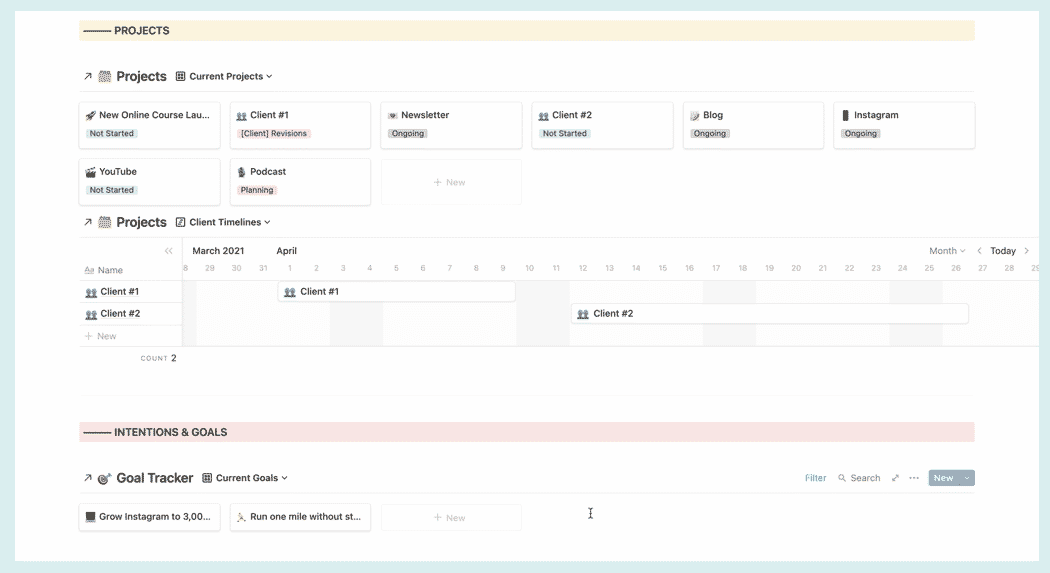
The Biz Dashboard is a page where you can see your business at-a-glance. Think of it as a living and breathing page of where you can implement the things you’re learning for your business.
In this dashboard, we have:
4Qs: These are the core questions you need to answer to know what you’re doing and what your business can offer to people. We talk more about this in the Foundation section of our 5-Step Business Checklist.
Goals: This is where we write our revenue goal for the year as well as list our business-specific goals from the Goal Tracker database.
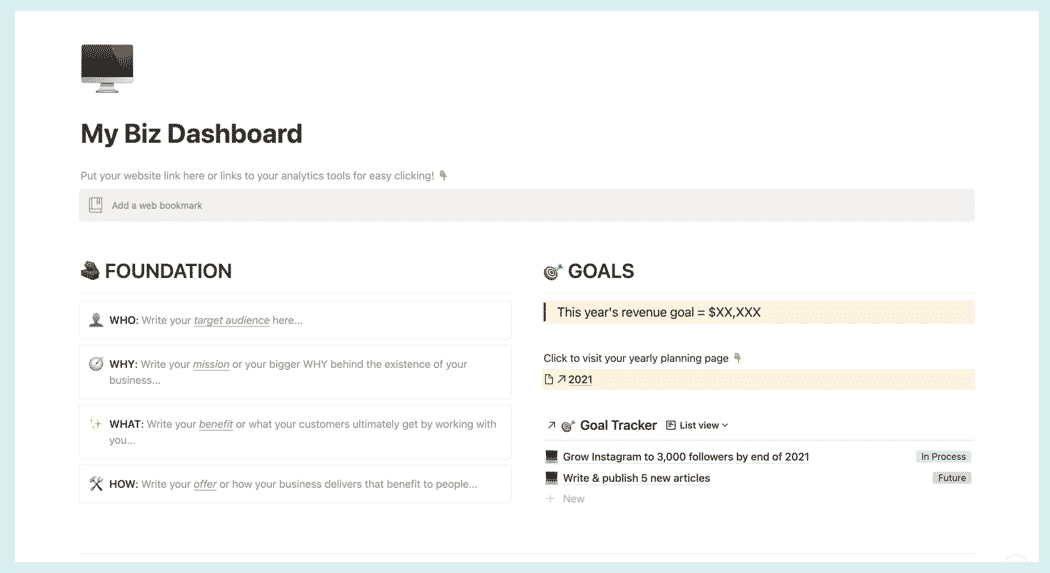
Marketing Bridge Strategy: This little section is where we can see at-a-glance, “Are we hitting initiatives at every step of the critical marketing bridge puzzle?” We share more about the Marketing Bridge concept in this article.
Project Focus By Week: Each week, we like to set our project focus which is especially useful if you’re juggling multiple projects at a time.
Growth: We also track specific metrics in our business each week such as traffic and newsletter subscribers.
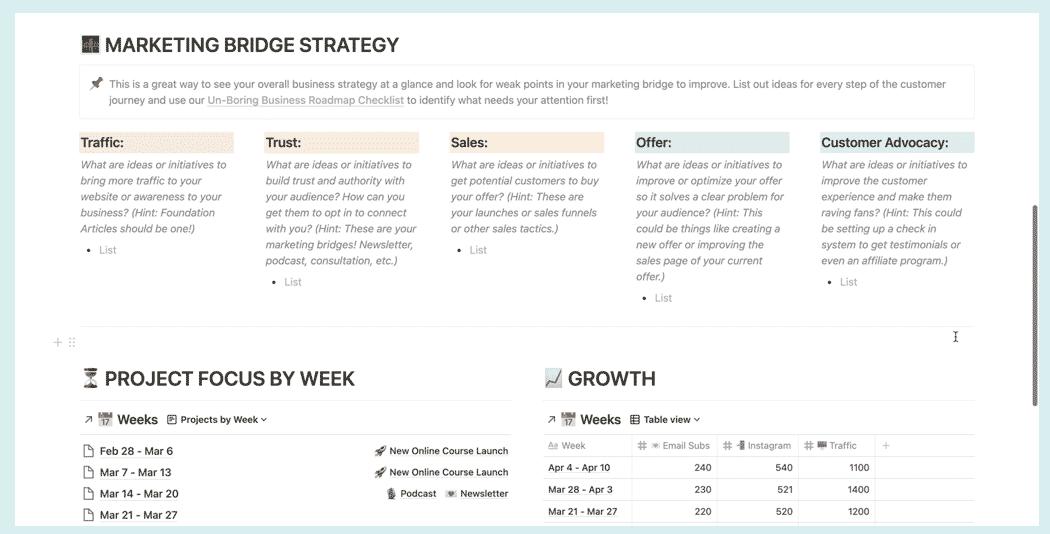
💡 Tip: You can also dedicate a space for business-related files! For example, you can compile all of the worksheets you’ve been filling out for to gain clarity on your business in this dashboard so they get lost in the catacombs of your file folders.
The Content Factory Dashboard helps us stay on track on all of our content channels. We use this dashboard to:
We’ve found that an efficient way for us to generate content ideas is to write all our ideas in a stream-of-consciousness style and then decide afterward the content channel that is best suited for each idea.

We use the same drag-and-drop concept for batch ideating and scheduling our Social Posts.
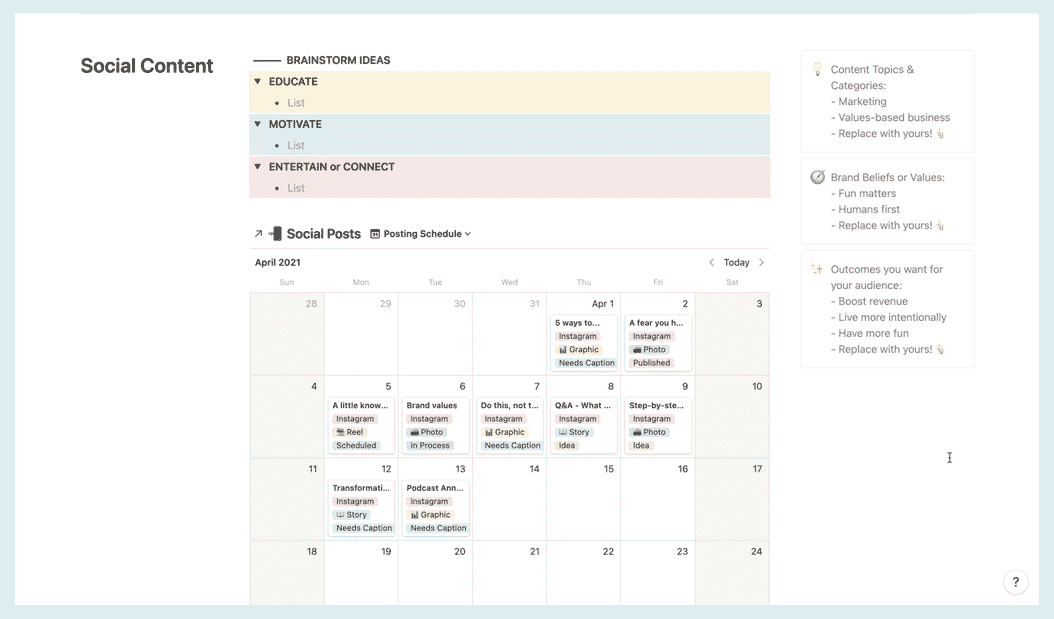
In the Scheduling section of our Content Factory Dashboard, we have a list view of our Content Calendar database which is filtered to show only the content pieces that have not been assigned a Publish Date, basically ideas that are floating around but haven’t actually made it in our Content Calendar.
From this list view, we can then drag each content piece idea to a calendar view (using the Publish Date) of our Content Calendar database to easily assign a publish date.
This process makes sure that all of our content ideas are captured and ready to be scheduled.
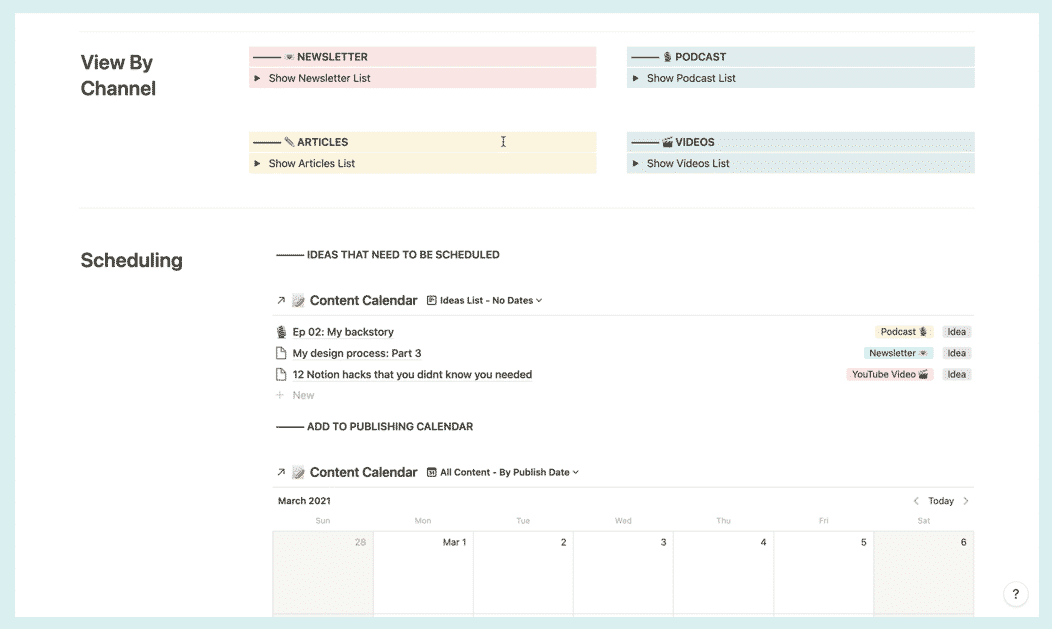
Once we’ve added our publishing dates, we go to this section to create tasks related to each content piece.
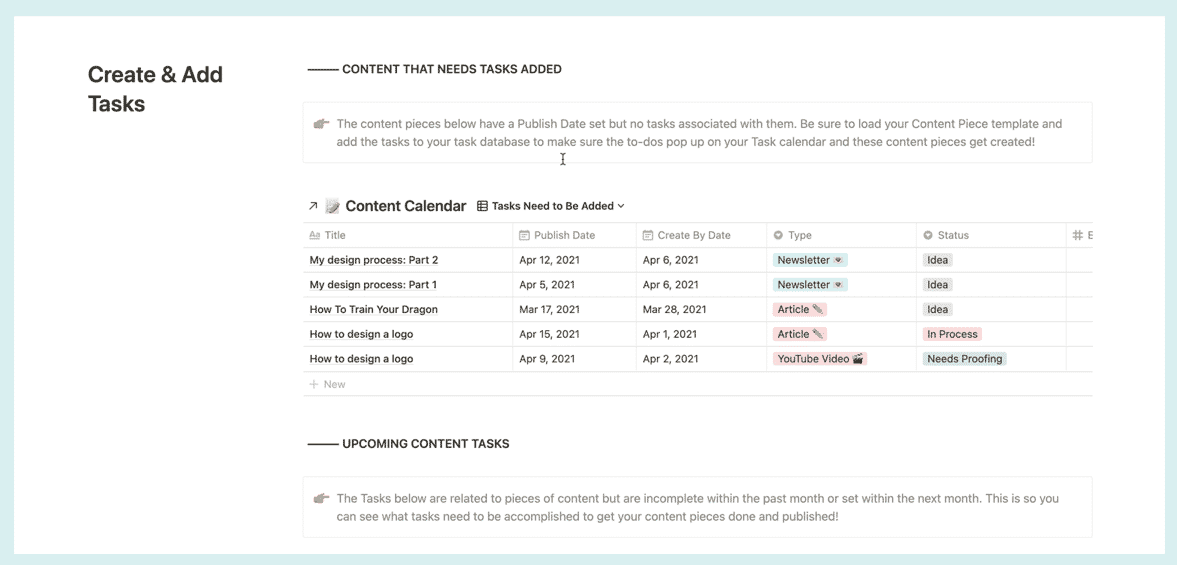
The pages in this category are the time-based pages and databases that help us check in regularly, plan for the future, and review all we accomplish.
The main databases for the Review part of the system: Daily Habit Tracking and Weekly, Monthly & Yearly Planning.
This is crucial because even if you spend all the time setting everything up in Notion, if you don’t come back to it often and don’t give yourself set times to invigorate and maintain the system, it will not work.
Even if you spend all the time setting everything up in Notion, if you don’t come back to it often and don’t give yourself set times to invigorate and maintain the system, it will not work.
In this database, each entry corresponds to a single day. We created properties to correspond to specific habits, metrics, and information we want to track on a daily basis.
Each day is also connected to a specific week in the Weeks database so we can review that information later on during the Weekly Review process (more on this below).
![]()
Moving on to the Weeks database, each entry in here corresponds to a single week.
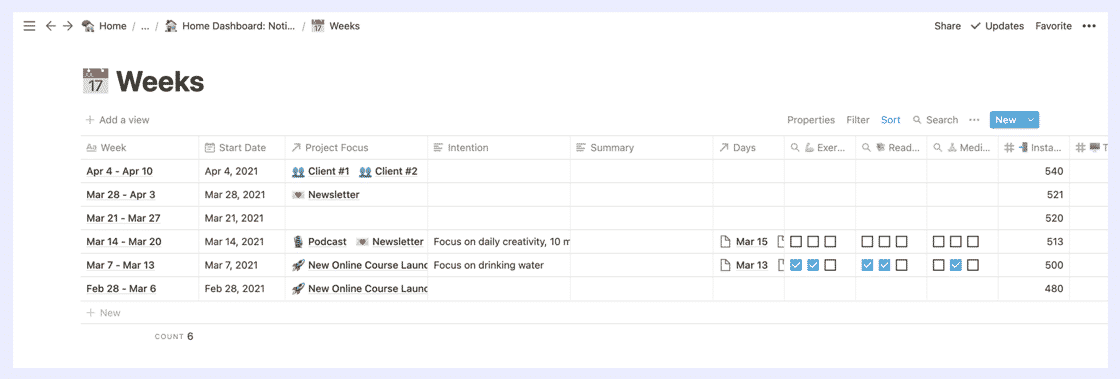
The properties for the Weeks database are a little bit different because it rolls up or aggregates the data you’ve tracked in your Daily Tracking database.
For example, if you recorded the following data for the Exercise habit (property) in your Daily Tracking database:
In your Weeks database, you’ll see this for the Exercise roll-up property:
You can roll up all kinds of data like habits, daily mood, sleep hours, business metrics (average traffic, total newsletter sign-ups), and even your daily gratitude.

Inside each of the Weekly pages (remember, each entry in a database is also a page!), we’ve created a Weekly Planning & Review Template.
In this page, we summarize what went well (or didn’t go well) and what we learned from the week. We check in on our Life Areas and Goal Trackers to see which areas we need to give more attention to. Then we hop in on planning for our Projects and Upcoming Tasks to make sure we’re on track or if we need to reschedule tasks. We also look at our Content Calendar and Social Posts to check our upcoming content pieces and make sure that we have enough ideas batched and planned for the next two weeks. And lastly, we have a section for tracking specific growth metrics in our business.
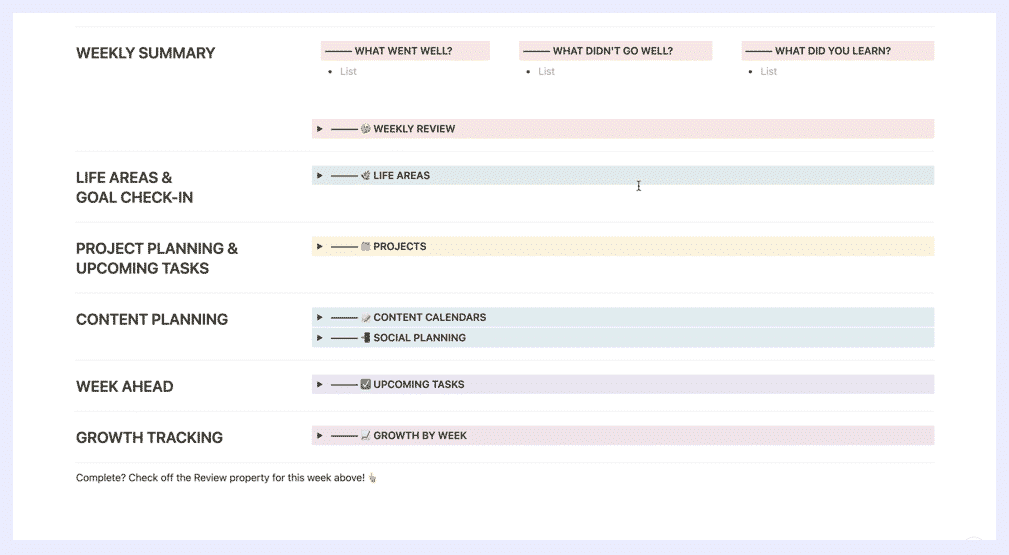
📝 Quick Note: Each section in this Weekly Planning & Review Template is actually hidden under a toggle button (that little triangle ▸ on the left side of each colored box). If we expand each toggle, we have content blocks that pull in data from all of the databases we’ve worked on in the Set-Up, Action, and Organize parts of the S.O.A.R. Notion System.
Think of it this way: Weekly Planning is Boss You and the Daily Dashboard is the Employee You. The Daily Dashboard is for getting stuff done every day and the Weekly Planning is for setting what needs to be done every day.
We also do Monthly and Yearly Reviews, which is set up similarly to the Weekly Reviews, but we review and plan broader aspects of our life and business.
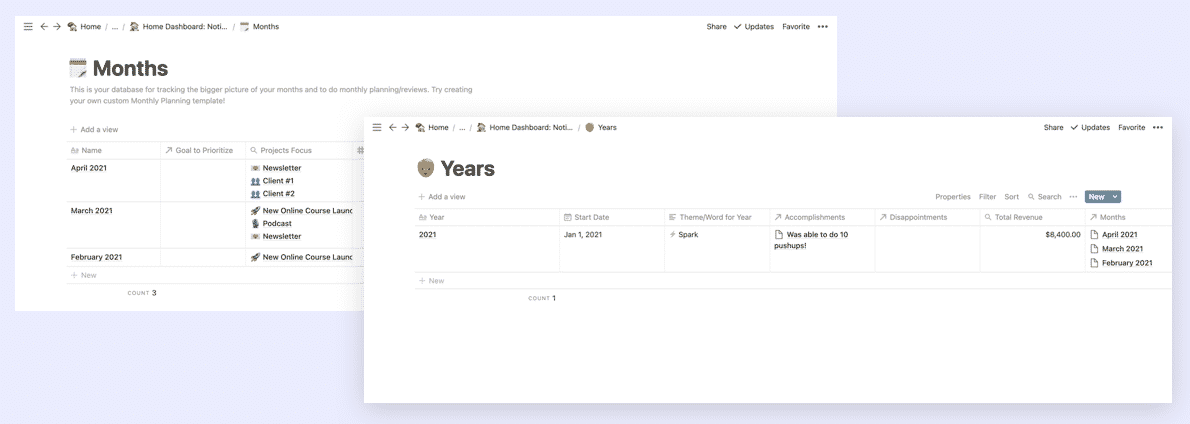
You can also watch us break down our (free!) Yearly Planning Notion Template in this video:
Now that you’ve got the lay of the land, let us show you how we actually USE our Notion System!
There are a lot of components in our Notion System so you’re probably wondering: How do all these blocks work together to help us actually run our business better?
Let’s walk you through it!
First, we set our vision for the year in the Years database…
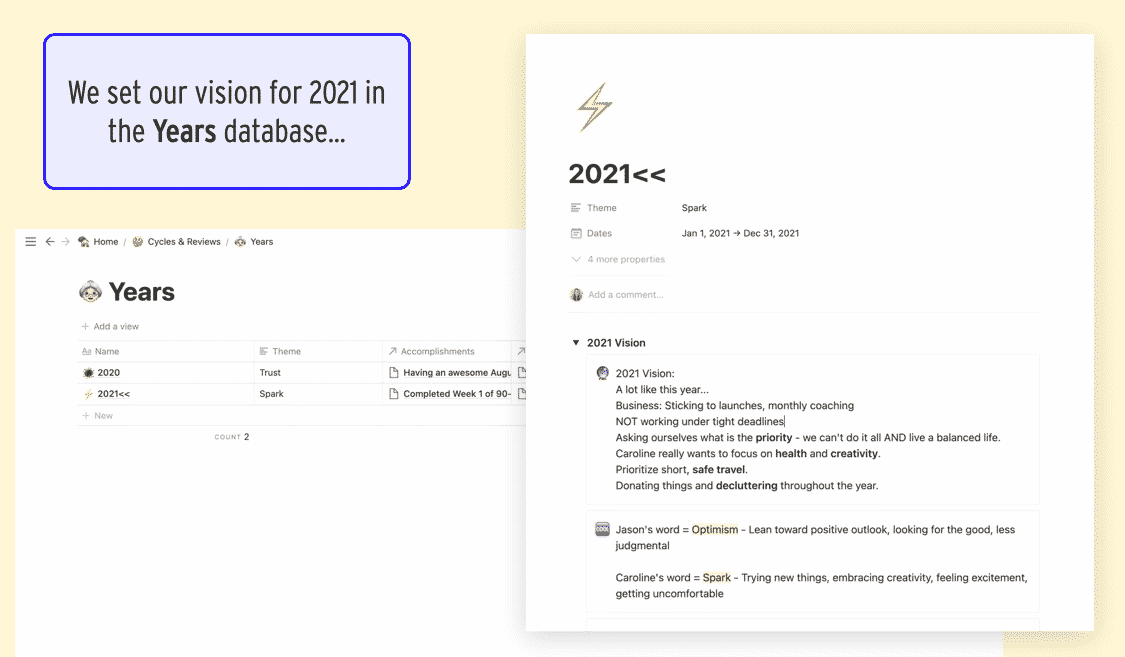
Then we turn that vision into concrete financial goals and project plans for Q1 in our Quarters database…

👉👉 For example: at the beginning of Q1, we set up projects for our January Flash Sale and Spring Enrollment Launch, and when we finally decided on the Notion Starter Pack as our spring “product,” we turned that into a project as well.
When we make a new project, we load our New Project template, and brainstorm tasks. We pull those into our Tasks database, and we’ll usually also estimate time for each task at this point too and assign a “Do Date”
We also usually add goals at the Project level as well so we know what we’re aiming to achieve with that project.

We have a project for each content channel. We plan our publishing schedule a month ahead at a time during our Monthly Planning meeting.
We do our monthly planning in the Months database…
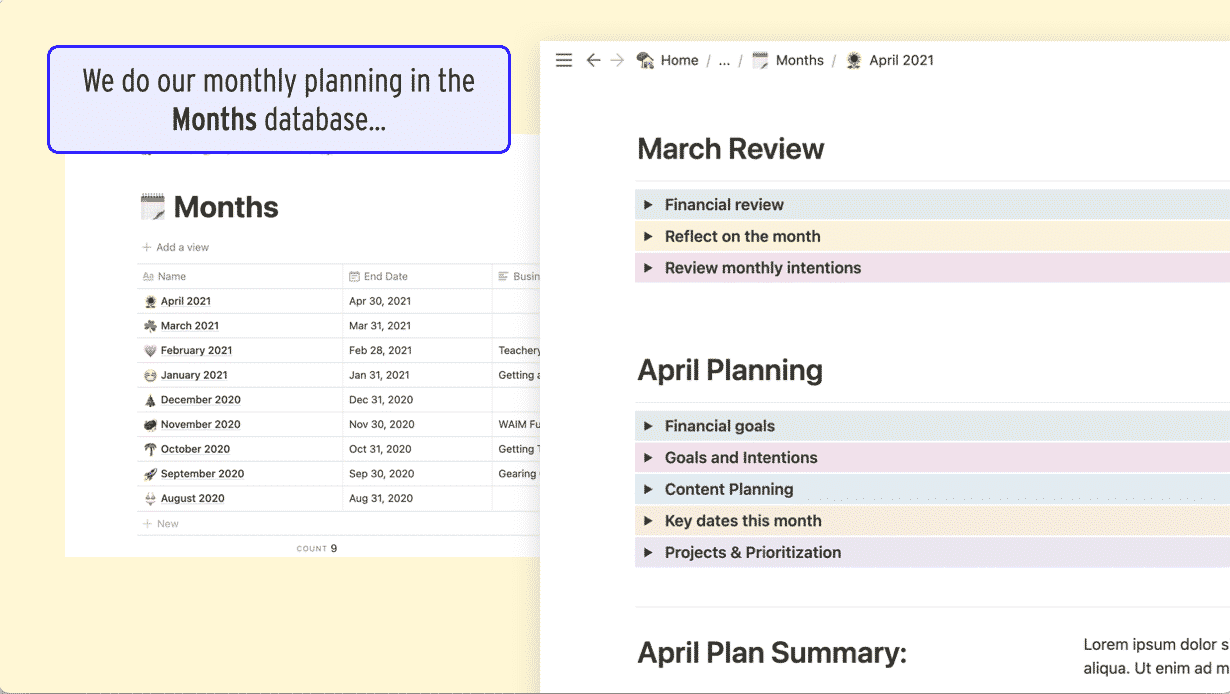
Usually, our Content Calendar is empty or half-empty at this point, which means we need content ideas!
We can use this page to come up with ideas or schedule content that are in the idea stage and needs a Publish Date.

For example, if we have an idea for a new podcast episode, we can add it in the Brainstorm section of our dashboard and drag it into the Podcast column.
Or we can go to the Podcast project page directly and drag our “Ideas” view onto our Calendar View to assign a Publish Date to them.
Once episodes have a Publish Date, that’s when we load in our “Podcast Episode” template and create tasks to actually MAKE that piece of content.

On a monthly basis, we also have our Budget Meeting 🤑💸. We use this dashboard page to input our expenses, our income, see our profit for the month, and see our spending compared to our budget.
We evaluate Life Areas, Projects, Goals, Content, and basically just check in with the whole system to see what needs to be updated or tackled in the upcoming week.
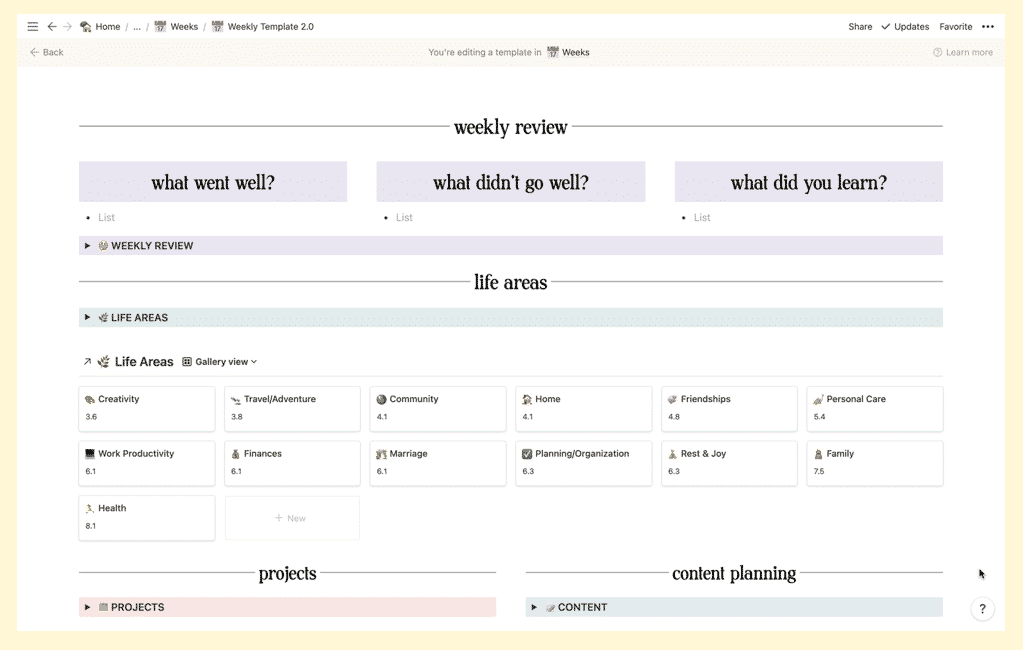
This is where I (👩🏻🦰 Caroline) do my “Intentional Balance Inventory” where I rate my Life Areas 1-10 based on how much attention they got the previous week. If I want to shift my focus to an area that is being neglected, I set that as my weekly intention in our Daily Dashboard so I see it every day.
During that Weekly Review, we’re also logging any stats we want to track for our conversions, etc.
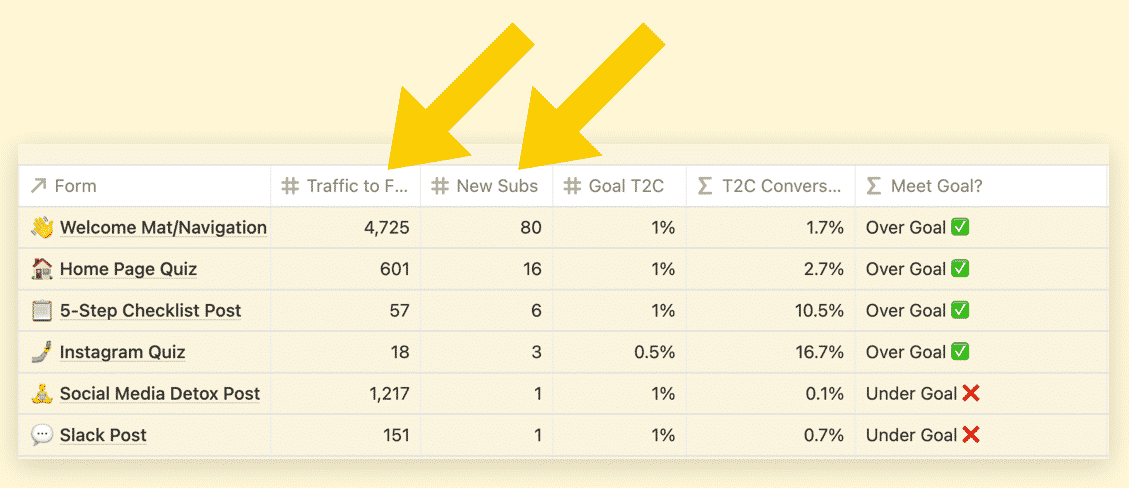
And, also during the Weekly Review, we’re rearranging any tasks for the upcoming week to better even out my schedule and batch tasks if necessary. Don’t be afraid to have a bad week and then need to rearrange your tasks, it happens to us too!
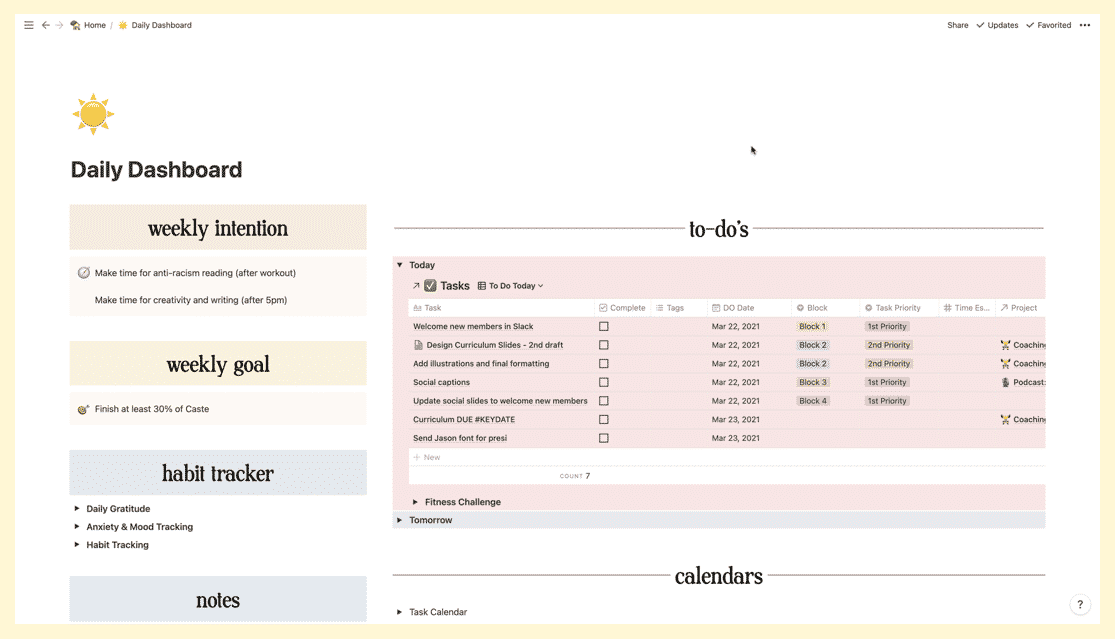
The first thing we do is add a new day to our Daily Tracking and we fill out our gratitude, our habit trackers.
![]()
This section of our Dashboard is where we spend our day though. We assign priorities to our tasks or we designate them for 1 of our 4 “work blocks.”
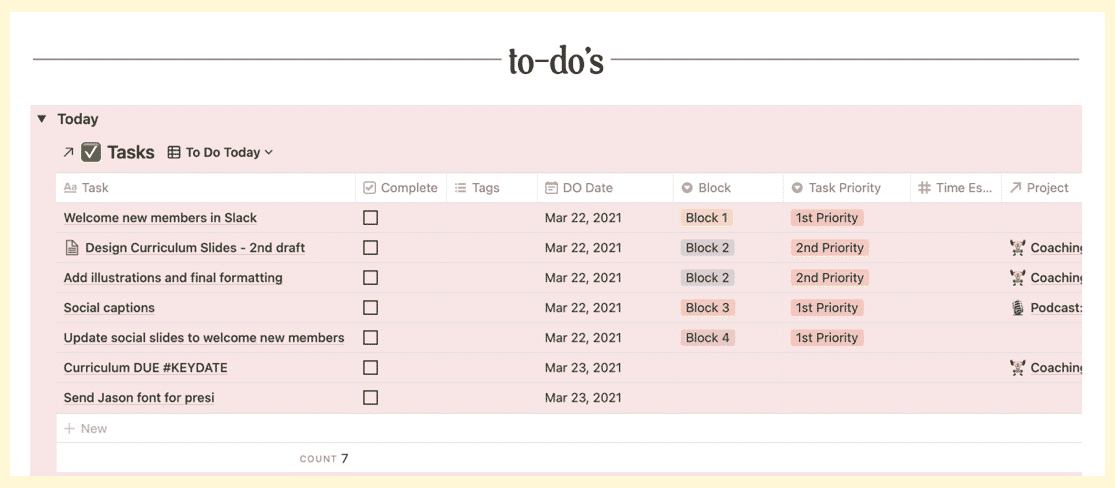
If it’s a task where we want to track our time, we set the Start Time when we begin and we set the End Time when we’re done.
That’s it! And still, you might be like… WHOA.

This system is complex but you’re really only updating it at specific times. When we do our Weekly Review, it usually only takes about an hour max but that hour is the most powerful hour that we spend on our business because it sets us up for everything else.
If your head is up in the Notion-clouds with all the databases, blocks, properties and dashboards, here’s a quick little zoomed out recap to show you how we use the S.O.A.R. Notion System to run our life and business:

We start by mapping out our year and setting goals for our life and business as a whole.
During the Quarterly Planning, we create our new Project pages, set up goals and create tasks for those projects.
This is when we set up our Content Calendar for the month, update our Content Factory Dashboard, and do our Budget Meeting to check in on our financials.
Every week, we review and update our Life Areas, set our daily intentions in the Daily Dashboard, plan our Social Posts, track our Growth metrics, and make adjustments to the Tasks we’ve already entered in our system.
This is where we do our Daily Tracking, where we take action on our Tasks, track our time and GET. THINGS. DONE 🥳
It seems like a lot but again, you’re only updating the system:
Everything else is working for you behind the scenes and you are just presented with the things that you need at the time you need them.
The final thing to remember: If your life and business have felt disorganized in the past, we’re with you! This system in Notion has really helped us get a stronghold on everything that’s important for us to focus on.
Good luck and happy organizing! 👋
That approach hasn’t worked for you, has it? It certainly hasn’t worked for me, either. We’ll spend countless hours creating an article, post, video, etc, only to feel like the crickets aren’t even interested in it (the jerks!) The problem is that often times we create content from the entirely wrong angle.
Too many content creators think, “how can I make shareable (or viral) content” instead of thinking, “how can I make really helpful or entertaining content?”
A few years ago I wrote an article about a 30-day detox I took from social media. I can distinctly remember the 2014 version of myself sitting at my laptop and cranking out word after word for that article. I remember asking myself a few questions while I was writing what would become a 6,000+ word post:
Do you notice anything about those questions? None of them have anything to do with making that article share-worthy. None of them involve some viral growth tactic to get tons of shares, likes, RTs, etc.
And yet… That 6,000+ word article has gone on to be viewed by over 500,000 people since it was published.
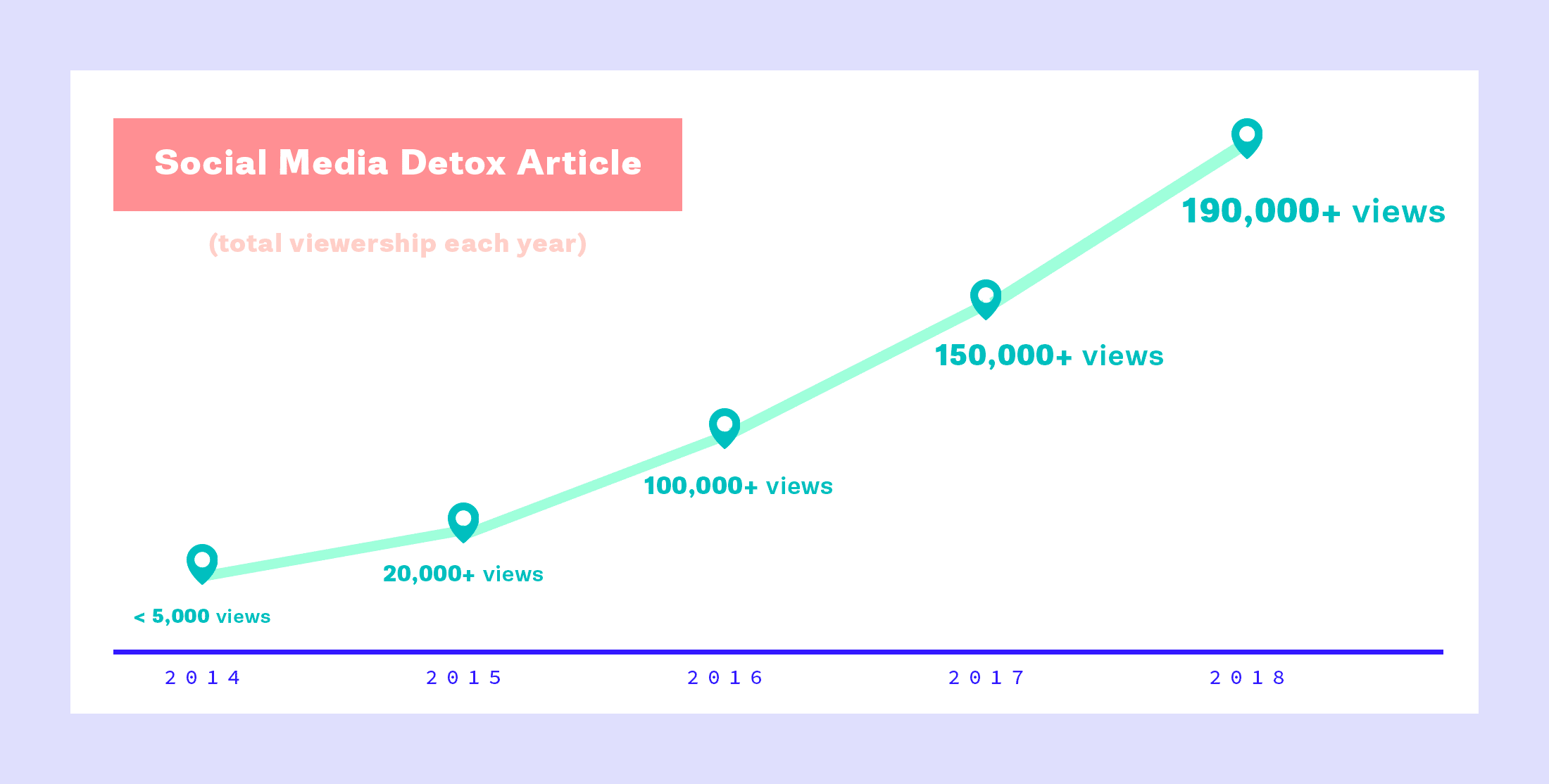
Fancy charts are fancy.
There are a few things to note about that article that may surprise you:
All things considered, I may as well have written, “don’t share this!” across the top and bottom of that article (obviously styling the text to match the yellow CAUTION tape you see at crime scenes).
If your intent is to create something under the guise that it will be shared you’ve almost already lost your battle to get attention from other people.
You need to create content that focuses on one or two things:
You can play all the keyword research games you want but if your content doesn’t help someone or doesn’t keep them entertained while reading it, you’re donezo. And kudos to you if you use words like “donezo” in your writing.
There is too much content in existence on the Internet nowadays and we’ve all developed a strong bullshit radar for growth-hacky content.
Now… hold on. Don’t flip over your desk in anger about how much you hate SEO and how much it confuses you and makes you want to punch pillows ’til the cows come home (a saying that I believe is catching on).

(Hopefully this isn’t you right now.)
When I talk about preparing your content for success, I just mean doing a couple of simple things that put you in good standing with search engines:
*Obviously this only pertains to WP users. For everyone else, just skip this step.
If you want to dive deeper into my extremely rudimentary process for SEO, read the full guide I created: Everything You Need To Know From My Experience With SEO
The reason to think about SEO just slightly when you’re writing content is to set yourself and your content up correctly from the beginning. Read: Do the things Google wants you to do so it can find and share your content for you!
Don’t aim for virality, aim for longevity.
For every single person reading this article (myself included), none of the content we create will go viral. And truthfully, virality should NOT be the goal. Viral content is a flash in the pan. It’s over and done with faster than you can blink, usually with zero long-term net gains.
However, long-lasting, quality content can continue on an upward trajectory. This is especially relevant if you create a piece of content, like my social media detox article, which was written before people started talking more and more about taking breaks from social media.

Thanks to my buddy (and SEO wizard) Brendan Hufford for helping me find this Google Trends graph!
You have to be patient with your content. My social media detox article didn’t start gaining organic search traffic and shares for months. In fact, it wasn’t until a year after originally posting it that people started to include a link to my article when they did a social media detox of their own and wrote about it.
IMPORTANT NOTE: I’ve had a handful of other articles follow the same pattern of how they took to get organic sharing and growth as my social media detox one:
There’s a recurring theme here and it’s that content worth sharing can take time to be found and to be shared. And again, none of those articles have share buttons, ask for shares, etc.
Takeaway #1: Don’t set out with the idea to create shareable content. Create helpful or entertaining (or both!) content.
Takeaway #2: Unless you can prove to me that those god-awful share buttons cluttering up your beautiful website are working, it’s time to remove them. They do not work. Great content gets shared because it’s great, not because a few buttons make it easier to share.
Takeaway #3: You can set yourself up for success by doing a little bit of SEO work. Just a few small things! You don’t need to hire an SEO professional.
Takeaway #4: Patience is incredibly important. If you’re creating helpful and entertaining content, publish it, share it where you can, then move on to the next piece of content you’re itching to create.
Takeaway #5: I didn’t mention this anywhere else but it’s probably time you go back through your older articles and see if you can make any of them go from good to GREAT. It’s easier to improve something that already exists than it is to create from scratch.
Unless this article helped you. Unless it inspired you. Unless it motivated you and gave you actionable steps you can take on your journey to having your content shared.
Otherwise, onto the next article you have open in those 43 tabs in your browser.
We’ve certainly said this on multiple occasions about our various business ventures.
But a funny thing has happened over the years as we’ve learned from our mistakes “running” our businesses: We’re damn tired of feeling like we’re always running!
With Wandering Aimfully we’ve made the public announcement of striving for enough. Not more. Not maximum profits. Not some arbitrary 7-figure annual income number. We actually did the math and figured out the amount of money we want to make to sustain the lives we want.
In May of 2013, I hung up my final t-shirt for my IWearYourShirt business and at the same time closed the flip-out LCD on my Canon DSLR video camera. After filming, editing, and uploading over 1,600 videos in a 5-year span (an average of nearly 1 video per day for 1,600 days straight) I no longer wanted to even think about creating a video, let alone touch a video camera. I was burnt-the-hell-out.
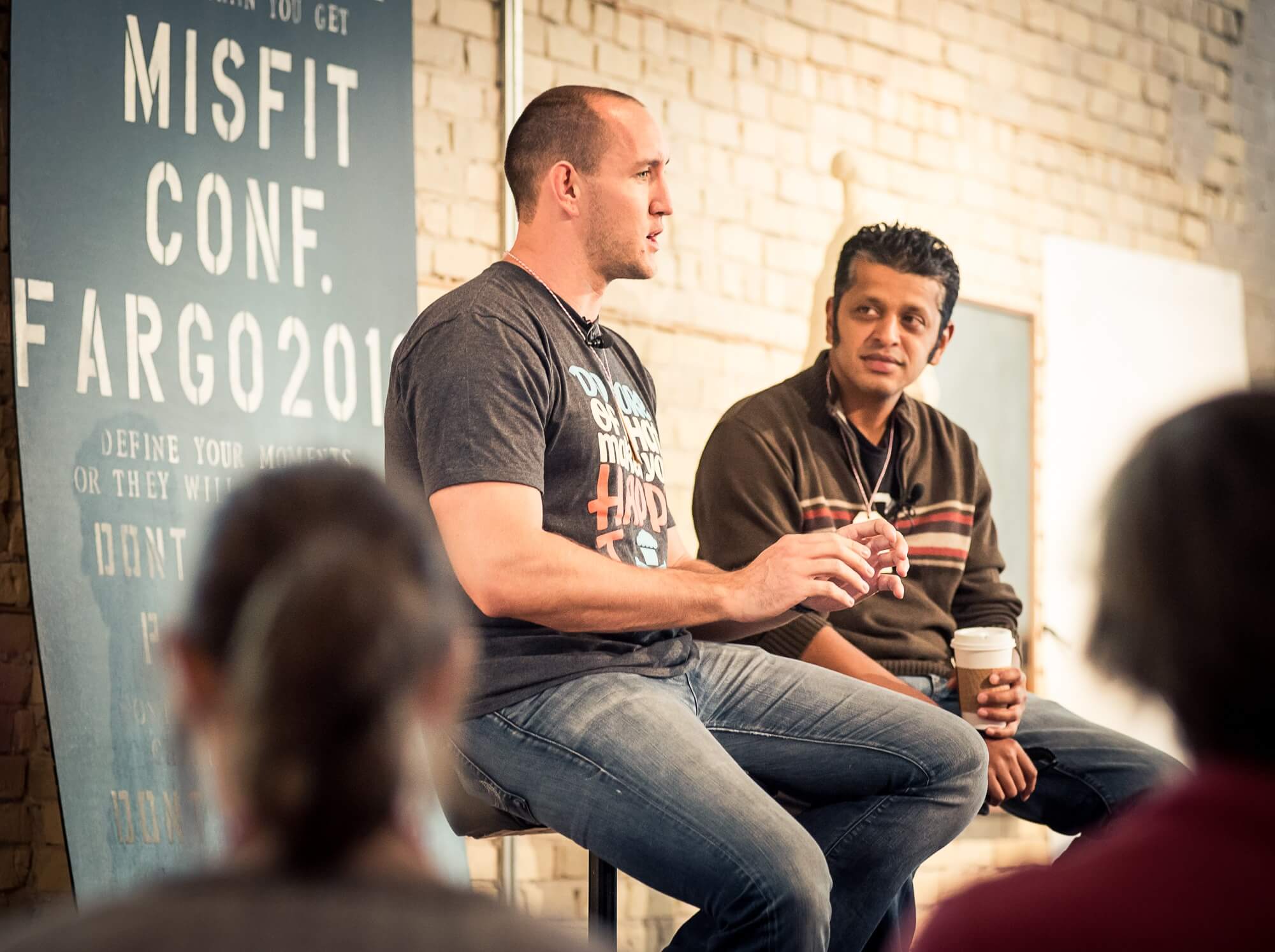
Admitting to a room of strangers in 2013 that I was completely burned out and my business was shutting down.
I’m not exaggerating when I say that it took nearly FOUR whole years to get over the negative feelings I had towards creating videos. Just thinking about the video-creation process gave me a swirling feeling in my stomach. Reaching for the video camera put me in a bad mood. Imagining myself having to edit any footage I shot made me depressed.
My feelings of burnout when it came to filming videos had come directly from “running” my IWearYourShirt business. I spent countless hours overworking myself to publish videos on a completely arbitrary schedule I’d forced myself into.
I left the 9am-5pm corporate world to chase down my own big idea (IWearYourShirt) only to find myself in a 9am-9pm job that felt like a career dungeon.
You’re currently running, running, running, with no end in sight and are afraid if you slow down everything will crumble around you?
As business owners, we often don’t realize the traps we set for ourselves and how much we over-work until it’s too late.
In 2018 I started creating videos again consistently with my wife but with a much more relaxed production schedule. I was NOT going to repeat my past mistakes. I was NOT going to work my fingers to the bone to push videos out quickly and at an unsustainable rate.
Instead, my wife and I…
An example video on our Wandering Aimfully YouTube channel.
This new mindset when it came to video production took me from feeling like I was always running around and burning the creation-candle at both ends to having a calm schedule that I could stick to and even get ahead with! (Novel idea!)
It can be hard to know, in the day-to-day of operating a business, if you are in “running mode.” Do any of these things hit too close to home for you:
If you feel the pain of those things we’ve been there with you. It’s incredibly common for business owners to get stuck in the spiral of these things for weeks, months, and even years.
Instead of running, think about short sprints.
We get it. You are creating a new thing. You are making a big transition. You are starting from scratch. No matter what, there will be times when you have to run and not walk. But you should think of these times as short sprints where you absolutely must set boundaries for your running time otherwise you’ll just continue to run.
When you need to put in the extra work, think of it as a sprint, not a marathon. Short sprints of additional working time that you will stop doing at a certain point and not allow to become bad habits.
We’ve all been preached the gospel of Hustle at one time or another. As I wrote in another article, We’ve Reached Peak Hustle-Porn.
Hustle should be reserved for short bursts (sprints!) Running your business should only need to happen for small periods of time. If you’re always going 100mph you’re going to get burned out.
I’m a firm believer that we’re all unique snowflakes, let’s get that out on the table. I truly think that every person has a unique skill and can offer something to the world in the form of their own business if they so choose.
However… That doesn’t mean everyone is cut out to operate their own business (running OR walking).
For some folks, the pressure and anxiety that come with the uncertainties of owning your own business are too much. That’s OKAY! That’s why there are a plethora of “real jobs” out in the world.
There is absolutely no shame in admitting that working for yourself is not the right path for you.
As much as you may want to work for yourself and chase down a big idea, it just may not be the right fit for you. Should you give a shot to see how it goes? 100% yes! But if it doesn’t work out you shouldn’t beat yourself up and you shouldn’t force yourself into debt, depression, or other negative things many of us go through.
We’re not going to lie to you and pretend you can just whisper our mantra of “I’m committing to walking my business” and POOF everything will change for you.
What we can do is tell you that IT IS possible to adopt the walking a business mindset even if you’re currently running.
We’ve seen it firsthand for our businesses and my example about our video production schedule is just one part of how we’ve made our shift from running to walking.
Here are a couple ways you can think about transitioning from running to walking your business…
Instead of focusing on never-ending growth, pick a number that you want to make monthly and when you hit that number stop. Don’t keeping going and working just because you can. Be content to use your extra energy and free time to enjoy the life you’ve created for yourself.
A tip for defining your enough number:
Total all of those up to find your enough number. If you want to read more about how we defined our enough number go here.
How many hours do you actually NEED to work each week to accomplish your tasks and financial goals? If you don’t create a cap, you’ll fill every waking hour with work. Caroline will often ask me around 5pm: Do you have more work to do today? And the answer is always, “there’s always more work to be done.”
If you own your own business, it’s hard to shut things down each day because our to-do lists constantly ongoing. By creating a cap of 5, 6, 7, or 8 hours of working time you won’t stay attached to your computer afraid of FOMO.
Do you need help managing your time? We have a few tips for you here.
For some of you reading this, taking any time off from your business will sound impossible. For some of you reading this, you may already be doing it (hurray, you!)
If it feels like you have to work on the weekends to keep up you are stuck in the “running a business” mode and you are going to burn yourself out.
Take the weekends completely off for the next two weeks and compare your revenue and work completion to the previous two weeks. Was the outcome drastically different financially? Did your customers throw up their hands in anger because you didn’t get back to them over the weekend? Did you enjoy time with your family or maybe get to some of those household projects you’ve neglected for years?
Those are just a few simple ways to transition from running to walking. Only you will know the areas of your business that are currently in control of you instead of the other way around.
From our own personal experience, we know that running our businesses only leads to health issues and burning out. Slowing down may seem incredibly difficult but if you are able to build better habits and make your business as efficient as possible, you can absolutely start walking your business.
Related: If this article left you feeling like you wish you had more to dive into to organize your business, especially how you manage your time and money (making your biz more efficient), we’d highly recommend going through our Back To Business Basics Guide. There are actionable worksheets and exercises to free up your time, generate more revenue, and get a better grip on your overall biz schedule.
Sometimes, though, I fear the way I talk about personal growth makes it seem as though once we discover what actions we want to take to live as our best selves, that seemingly overnight we’re able to simply make those changes and accomplish just that.
Like…
We decide we need to be more self-disciplined so we wake up the next day able to stay focused and on-task, and suddenly we’re living our best life.
We decide we need to rest and take better care of ourselves, so from then on we no longer overwork ourselves and burn out and, ta-da, we’ve changed!
But that’s NEVER how it actually works, is it?
It took me so long to learn this. For so long I tried this strategy: I’d find myself in a moment of “I know I’d be so much happier and brighter if I just did better with xyz.” I knew what needed to change, and maybe I even made better choices for a while, but a month or two later when I went back to my old ways, I felt like a failure. I would judge myself for sliding backward, not making that change.
That awful feeling of letting yourself down… I’ve realized that’s often the most powerful force that holds us back from real growth. We judge ourselves for “failing” and the next time we don’t even try to do better because we’re tired of feeling the guilt and disappointment of not being able to suddenly wake up and do a 180.
But last year I tried something new. I realized I needed to stop making the goal to do a complete 180-degree change in whatever area of my life I was focusing on.
Instead I started asking myself: What if I just focused on trying to get 10% better at whatever I wanted to change?
What if I just focused on trying to get 10% better at whatever I wanted to change?
What if I drank more water 10% of the time? What if I was better about reaching out to friends just 10% more? What if I managed my daily schedule better just 10% of the time?
By changing the goalpost to something so seemingly manageable, I stopped finding myself in the dreaded loop of self-judgement.
Lasting change and living your brightest life ultimately comes down to tiny micro choices. In any given moment, you can choose what feels easy and comfortable OR you can choose what that best version of yourself would choose.
Imagine you are a dial or compass pointed in one direction. Most of us view change as a complete 180 degree rotation to get ourselves pointed in a new direction. Instead, this new philosophy has me viewing change as the sum of tiny 10 degree turns toward whatever that “best” version of you looks like.
Jason calls this 10% better strategy “18 not 180” (which, coincidentally, feels especially appropriate for the year 2018).
So my challenge for you this week is to think of the one or two most pressing areas of your life or habits that you are trying to change, and I want you to try getting just 10% better.
Try rotating those measly 18 degrees, not a full 180. See if it feels easier and more doable to slowly drift toward your brightest life, rather than feeling guilty or disappointed for not being able get there overnight.
#18not180. I’m making it a thing. A gentle reminder. A mantra. A cheat code. Whatever you want to call it, I hope it helps you make 2018 your best year yet.
Thanks for reading!
The idea of becoming a better writer is daunting but I’m living proof that you can improve your writing, especially if you start out as a really crappy writer (hah!)
You’re not a writer—Stephen King is a writer.
You can’t write anything about marketing—Seth Godin has written it all.
No one wants to read your opinions—everyone has their own opinions to sort through.
You have no writing credentials. You didn’t go to school for writing. You’re terrible at grammar, punctuation, and using parentheses. (I still don’t think I do this “correctly.”) People don’t need yet another thing to read.
Now, granted, I didn’t actually realize I was committing to becoming a full-time writer. I had merely decided to step away from a business and the audience of 25,000+ people that came with it. I had decided I would instead share my experiences as an entrepreneur—the real experiences, not the hacks/tips/secrets/3 easy steps that pepper the headlines of prominent media outlets.
But when you have zero experience writing, except for 140-character messages to random strangers on Twitter, where do you start?
From the experience I had filming daily YouTube videos, creating a daily writing practice made perfect sense. When I started filming daily videos for my previous IWearYourShirt business, I had absolutely zero experience (the same experience I had as a writer).
The first videos I created were cringe-worthy; in fact, I still can’t watch them. For some odd reason, I thought my writing would be different. Spoiler alert: It wasn’t. My early writing is cringeworthy, but that early writing has helped me overcome the fear of writing. The fear of comparing myself to other writers. And part of that process is allowing myself to be a bit more vulnerable with my writing.
Based on my research, I committed to four things when I made the decision to stick to a daily writing practice:
And so I committed, starting on June 1, 2013. I didn’t have a repository of writing topics. I didn’t know exactly what I wanted to be writing about. I just knew I wanted to try out this writing thing.
The first few days? Not fun. As soon as my butt hit my blue yoga ball (what I sat on at the time), the doubts I wrote at the beginning of this article ran rampant through my mind. But instead of letting those thoughts control me, I fought them by hitting the keys on my keyboard. Without a succinct topic to write about, I’d just write my exact feelings or stream of thoughts.
Day after day, the writing practice got easier. The pressure I put on myself to write something worthwhile started to lessen. My writing actually started to improve.
Once every couple of days, I’d have an idea for an article that seemed interesting or that I thought may be valuable for other people. There was no Action Army back then. There were no Road Runner Rules. I had no idea who I was writing for or why I thought they would even want to read my writing. I just wanted to share my thoughts.
Coming off a business where I hosted a daily live video show that shared 90% of my life, I knew I could make an easy transition into writing something similar. Instead of trying to create some fancy way of writing or spending arduous hours trying to figure out interesting topics, I’d just leverage something I had at my disposal: my life.
“Sharing my life” was familiar to me, but it also looked a certain way. During my days of hosting a live video show and representing a different company on my t-shirt every day, I couldn’t have bad days. I couldn’t complain, be upset, or be honest if I was feeling pressure and stress. That would reflect negatively on the brand that was paying me, and I knew that wasn’t fair to them. Sure, I probably should have seen the writing on the wall that it wasn’t a healthy way to operate my life/business, but we all make mistakes.
Once I removed the shackles of worrying about representing a company, I felt the freedom to share what was actually going on. I felt a burning desire to let the world know that everything wasn’t okay because I knew everything wasn’t okay for other people as well (or at least I hoped I wasn’t alone in thinking that).
That shackle-removal was the best thing I did for my journey into writing. Being more vulnerable and honest about my life and business pushed away people who only wanted to see a perfect life and pulled in people who could relate and who shared my thoughts and feelings. Writing about Feeling Lost, Values, Friendships, and various other topics attracted the types of people who were going through (or had gone through) similar things. And when they commented or emailed to thank me for my words, it was a life-changing revelation to me:
I could be real about things not going perfectly, and people wouldn’t scatter away like cockroaches when you flick on a light in a dark dingy motel room.
Defining the audience I was writing for was extremely painful for me, but I knew it was necessary. I had seen with my previous business that having a very broad audience led to a lot of surface-level connections. Without a deep-rooted (and defined) connection, those audience members would leave at the drop of a hat to find the next shiny object. Luckily, my life partner eats bowls of soul-searching-deep-rooted connections for breakfast.
I had countless conversations with my wife, Caroline, about “who I wanted to be writing to” and “why I wanted to be writing to them.” Just typing those words makes my stomach do a slight turn. Not because it’s cliche or extremely commonplace to think about those things, but because it felt so limiting and constricting to me.
How I thought about defining my audience: This will limit the number of people I can attract, which will limit the amount of money I can make, which will make me feel unimportant and not unique.
How defining my audience actually makes me feel: I have attracted a specific group of people who can benefit from my writing. I’m empowered to know I’m making an impact on people’s lives (impact > number of eyeballs).
Bonus resource: I sweet-talked my wife Caroline into letting me share the Ideal Audience Profile PDF that we used to help me define my audience. This PDF is actually only available in her Better Branding Course, but you’re getting it for free because I’m a master negotiator (and because I agreed to do the dishes a few extra nights).
As I’ve written this article, it’s for the Action Army, a group of people who want to take control of their businesses and do things in ways that align with who they are (not who society says they should be). But the Action Army could transition into something completely different in six months or two years. I’m 100% okay with and open to that change, because I know I’ll continue to evolve the definition of who my writing is for.
I didn’t have the Road Runner Rules exercise when I first started writing. Instead, I had one guiding principle: I wanted my writing to be useful to other people.
Actually, I think I had two guiding principles: My writing would be helpful, and I would avoid the awful trend of articles that start with “27 tips to…” and “6 important hacks for…”. Sure, every now and again, I’ll write an article that has a number in the title, but out of my past 100 articles, only 8 of them have had numbers in the title. I’d say that’s sticking to my second writing principle.
“Is what I just wrote useful?”
Whenever I sat down to write or finish an article, I would ask myself, “Is what I just wrote useful?” The answer means 90% of my writing never sees the light of day. It’s not useful. It’s just words, jumbled together, often without a cohesive thread. I keep doing it because I like the writing process, but I’m being 100% serious when I say I have 24 articles in drafts right now, most of which are between ½ and ¾ complete because they’re not really useful. Yesterday, I wrote an entire article about what I learned from taking out my smelly trash. That was fun, but I think I’ll trash it. 😉
I wanted someone to read what I’d written and one of two things would happen:
I like to think of my early writing like my younger self. Full of flaws, trying too hard, and lacking the experience or confidence to deliver something of actual value.
That may sound harsh, but I believe we’re all our own worst critics. And hey, that’s how I reflect on the beginning of my writing—it’s not where I am today. I 100% realize I’m not the next Kerouac, Nietzsche, or even Stephen King, but I’m also not trying to be. I don’t aspire to be a great writer or to win awards for my writing. I aspire to write useful things. If I’m doing that, I’ll continue to keep writing.
I’m writing a lot about entrepreneurship and living an intentional life these days, but maybe I’ll write the next great fiction series? Maybe I’ll get really into carpentry and write all about how to carve chairs out of sporks?
I’m completely open to the evolution of my writing as long as it stays useful. One of the things that’ll stay intact for me in all my future writing will be bringing my audience (you reading this) along with me. I thoroughly enjoy sharing my experiences—again, the real experiences, not a sugar-coated version that will make headlines for major media companies. I enjoy the deeper connection my writing helps create, and I’ll continue to invest in deepening that connection for as long as I can.
Ahh, Search Engine Optimization (SEO), the mythical sasquatch for online writers these days. So many people buy the advice to write for search engines, and to stuff their “content” full of “keywords.” I’ll be honest: talking like that make makes my left eye twitch.
Let’s take a look at organic (search) traffic of JasonDoesStuff.com since I started sharing my writing consistently (weekly) in January of 2015:

One of the things you’ll notice right away are the two gaps. The first one, from January 2015 – August 2015, shows almost zero search traffic. That’s not surprising since it can take 3-6 months for a site with new content to index in Google. This is the stage of creating content when you just have to believe in your writing (you know, when NO ONE is reading it 😂).
The second gap was a month when my website was offline and being redesigned. Notice that it didn’t affect the overall organic traffic growth after it was brought back online (yay!)
None.
Well, that’s not entirely true. My friend Paul Jarvis gave me a great piece of advice that I still adhere to today: Write for people, not for robots.
I like Paul’s advice, and I haven’t concerned myself with a single other SEO strategy since then. I don’t care about what to put in H1, H2, or H3 tags. I don’t count my words. The only SEO-related WordPress plugin I have on my site is Yoast. And the only reason I have it is because my buddy Ben said I should. I fill out the title, keyword, and meta description with each article I write. But I have no clue if I’m picking the right title, keyword, or metadata. I’m just inputting stuff that feels right.
Otherwise, I’ve just continued to write consistently useful content. I’ve listened to my reader’s suggestions, and I’ve tried to write about the things people seem to actually want to read. I’m happy to let the search engine robots (Skynet!?) figure out the rest of the details.
Could I be getting a lot more organic traffic? Probably. I’ve seen all the same articles/webinars/courses you have about the topic. But that would be a lot of time spent focusing on things I don’t want to waste my time with. I’d rather enjoy the process of writing for and helping others, and not concern myself with eeking out a little extra traffic here and there.
Your words are good enough as long as they are your words. It’s easy to copy. It’s easy to put a slight spin on something Seth Godin’s already written. In fact, that’s a great place to spend 90% of your writing time. Just be willing to throw away the unoriginal stuff that isn’t useful.
Share your stories. Your stories are unique to you. Even if you aren’t going through crazy things in life, you’re experiencing things in a way that other people can resonate with. This is how you build an audience of readers.
Be willing to throw away your writing. At least early on, your writing is nothing more than an exercise to help you grow and get better. If you start with this thought (or change your current thinking about it), writing becomes way less stressful and can be done with much less pressure. Eventually, you won’t need to throw away your writing (maybe).
Embrace vulnerability in your writing. Writing my book Creativity For Sale was one of the most cathartic things I’ve done in my life. It allowed me to share a lot of thoughts and feelings I’d bottled up. I do the same thing on a weekly basis with these articles. You don’t have to pull all your skeletons out of your closet, but maybe start with a handful of them that you think other people can learn from.
This article on becoming a better writer went through a few revisions to make sure it met my #1 rule of being useful, but it also came together a lot more easily than 2500 words used to. I’m more comfortable writing these days than I ever have been, and even though I still don’t consider myself a capital-W writer, I don’t think I (or you) need the title to do the thing.
Just start writing, and see where it takes you.
There are times when you feel like you just can’t get any work done. Your thinking isn’t clear. You have too many things racing around in your mind and instead of buckling down and getting to it, procrastination is at an all-time high.
You fall into Workload Paralysis: You stress about all the work that needs to be done to the point of needing an escape, only to come back and see even more work to be done. And on and on and on…
It’s a dark place to be in, but there is a solution. It might seem counterintuitive, but I strongly believe that setting limitations and constraints can help you get through procrastination and help you get more done.
We’ve all been there before. We feel the squeeze of a deadline and somehow manage to hunker down and get the work done just in time. Often times during the ‘squeeze’ we feel like we get in the ‘zone’.
You know the zone right? That place where you just seem to be firing on all cylinders and to-dos get knocked off like falling dominos.
One of the best ways I’ve found to master my work output is to be very strict with my calendar. For example, while writing this article I blocked off 1.5 hours. During that time my email was closed, Google Chrome was minimized, my phone was out of sight. I put on some music that helps me focus while writing (Odesza and Pretty Lights). Then I just write. Free from distractions and any potential procrastination. Of course I have moments where I can’t think of what to write next or I can feel the pull of social media. But I remind myself of the limitation I’ve set and stay focused.
My weekly calendar is filled with similar events.
There aren’t a lot of free hours in my day. 90% of the events, however, have nothing to do with phone calls or meetings. Heck, I used to even set times on my calendar to check email and social media (thanks 4-Hour Workweek).
I block off time on my calendar for writing, for strategy sessions, for customer support stuff, for life tasks (appointments, errands, etc), and I even block off time to NOT work.
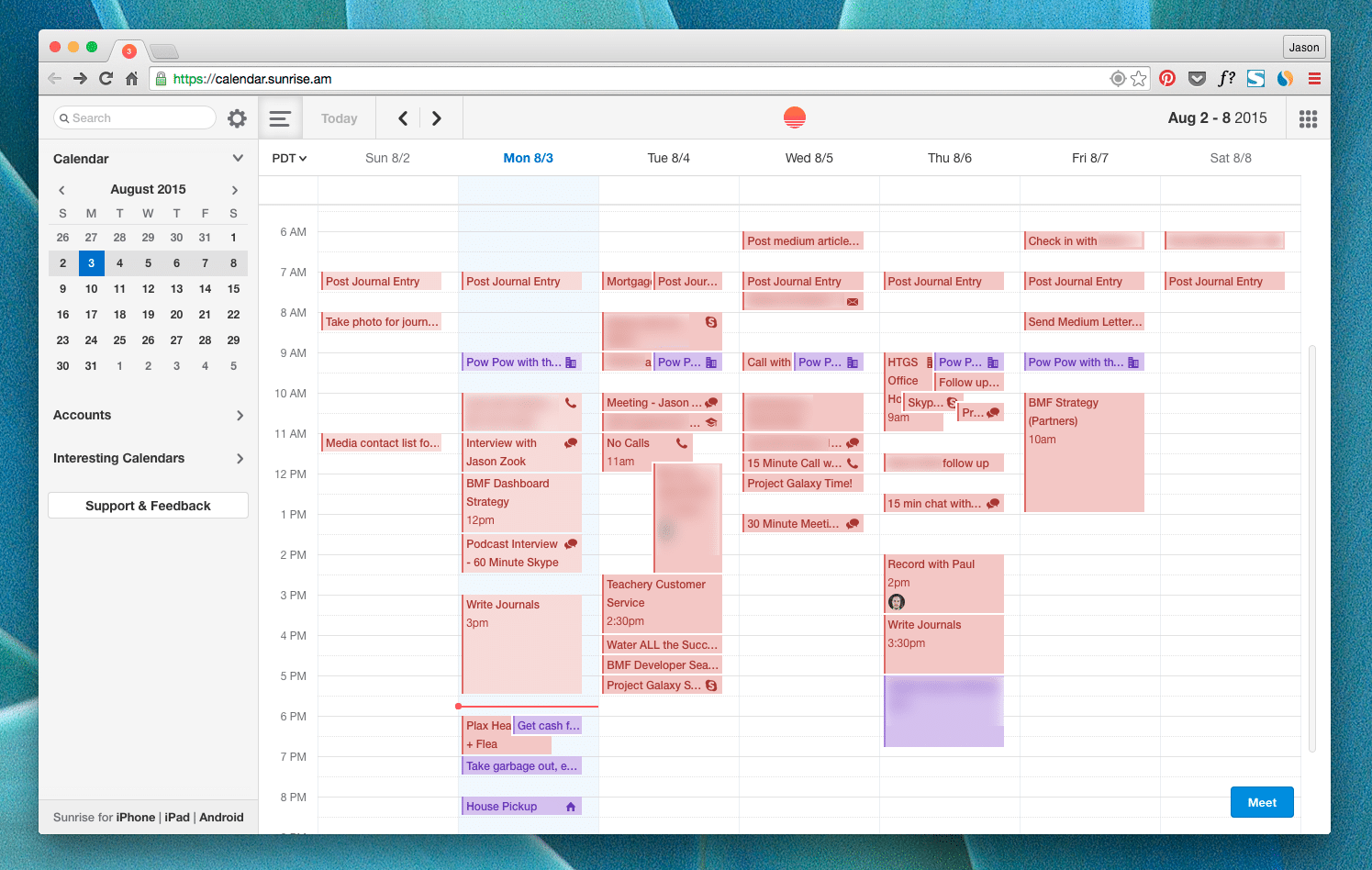
(A screenshot of my calendar during the BuyMyFuture planning and build.)
Why I only allow myself 30 minutes (or less) when going to the grocery store: No one needs to spend an hour browsing the aisles at the grocery store. Plus, this little trick keeps me from buying extra things I don’t need (because that would take too much time). I’m in and out, with only the items I needed, and I can get back to work or back to time off from work.
If you don’t feel you have the willpower to let your calendar dictate your life, try finding an accountability partner for a while. If you don’t have friends you want to trust with this task, hire a virtual assistant. For the $20-50 you’d spend a week having someone nag you, it might make you want to stick to your schedule more because you’re spending money on it.
Plus, it’s human nature not to let someone down. Whether that’s a friend or stranger somewhere else in the world, accountability can be very powerful.
We have too many tools at our disposal. A simple Google search for “writing app” brings up 252,000,000 results. Holy crap. How does anyone decide where to start? And the answer is not to click through until Page 5 or 6 in the Google search results, that’s just ludicrous.
The key is just to pick one tool and limit yourself to that one thing to start. Personally, I like to pick the tool with the least amount of features. As an example, I use the Bear App for writing. It doesn’t have a toolbar. It doesn’t have text decoration options. There isn’t even any text formatting. Not being able to waste time with features helps me get in the writing zone very quickly.
(The Bear writing app in action – This is where all my articles start!)
But how did I find Bear App? Through a friend on Twitter. A friend I trusted the opinion of and I knew was also an efficient writer. It’s one thing to take a recommendation from a friend who has successfully used that tool to their advantage. But if they’re just gushing about all the shiny and ‘interesting’ features it has, that might be a red flag that their recommendation isn’t the right thing for you.
Another way to test a tool is to set limitations with it. Let’s say it takes you one hour to do an existing task with an app you’ve been using for a while. If you want to try a new app, only allow yourself an hour to perform the same task. If you can’t get it done, then the new app isn’t worth the time investment. If you’re able to do the same task in half the time, then you definitely should switch apps.
It’s my honest opinion, coming from someone who’s created a dozen online courses, written two books, and built four software applications, that having constraints is a beautiful thing.
When I say constraints, I’m talking about a few specific things. The first is only doing the essential things needed to complete a project. The second is not letting assumptions dictate the amount of work you do.
Let me break both of these down for you…
Yet by constraining yourself to only work on a few things, you have a better chance of actually finishing your project and creating something with value. Here’s an example:
I have an online learning product called Teachery. For a year my co-founder Gerlando and I were heads-down building the best online course building tool we could, with the least amount of features possible.
Every time we’d think of a new feature idea, instead of spending time on it, we’d put it in a massive to-do list in Basecamp. Early on we set goals to help people quickly and easily build and sell beautiful online courses. If each feature we came up with didn’t directly relate to our goals, then it got put in the to-do list queue.
Recently we archived a queue of 50+ feature ideas. They weren’t bad ideas either. But by constraining ourselves to stick to the core features and work on perfecting them, we’ve been able to hit all our goals and milestones (which can be extremely tough when building a software product).
Now, when it comes to assumptions, I want to share an example of an online course I recently created. When I was writing the outline for the course I had 12 topic ideas. But when I sat down to create the course I told myself to pick the top 8 ideas I thought were most important to open up the course for purchase.
I assumed that people would be interested in the other 4 topics, but knew they weren’t absolutely necessary. I wrote a note in my outline next to those 4 topics that said: “If 5 people ask for any of these, I will create and add them as lessons in the course.” This small step would help test my assumption that people would want this information. So far no one has asked about any of them.
Now in both of these examples, you could argue that my projects could have been better with all the additional features and topics. And while I agree with you in principle, I also believe in the quote “Done is better than perfect”.
I’ve seen it with my own projects and with entrepreneurs and creative professionals time and time again. You want to over-deliver as much as possible to show the value of whatever you’re building. But it’s much easier to launch with less and add to a completed product, then it is to struggle to get a product to market that has a feature list a mile-long.
They help guide you and give you a compass to reach the finish line of whatever you’re working on. Lots of people get projects to 80-90% completion. Those same people struggle to get sales and always seem stressed out and overwhelmed. Get the best, smallest version of your project done and revel in your successes.
There’s a ton of power in completion.
Last Friday’s post was all about using creative progress maps to help document the formation of new habits.
In the past few months, I’ve written about my perspective on the power of consistency, how to stay accountable to yourself as you build new habits, and how to get back on the horse when you break the chain of consistency.
It’s entirely possible that by now you guys are getting tired of hearing about habits, BUT I continue to write about them because they really have changed my life.
Whether it’s been intentionally making time for creating art every day, or trying to make my health and fitness a priority, my attempt at successfully integrating new habits has always been about designing a life around my authentic self.
BUT there’s always been one thing that has nagged at me when it comes to habits. Why do certain habits come more easily to me than others? Why are some easy to follow through on and others it feels like an uphill hike on a hot summer day?
For instance, I’ve successfully completely at least six 30-day lettering challenges in the past year and a half, but I’ve fallen off the wagon more than a time or two when it comes to instituting a fitness regimen.
What makes these two tasks different and why is one easier for me to stick to than the other? This is something I’ve always wondered.
Yesterday, I rolled out of bed and decided to go for a morning walk (something I used to do all the time in Florida but haven’t done since we moved to California.) I always use that time to connect with nature and listen to a podcast episode to get my brain warmed up for the day.
As I left my driveway this morning, wouldn’t you know it, the first podcast episode in my queue was one from The Lively Show with guest, Gretchen Rubin, the author of a book that greatly influenced my life a few years ago, The Happiness Project.
I was only a few minutes in and I realized that Gretchen has a new book out, Better Than Before (a fact I somehow missed despite what I’m sure was a boatload of book marketing dollars – sorry publishers! You can’t get me! Muahaha!) Apparently, the entire focus of the book is on mastering habits and how our personalities affect the way we adopt new habits.
What?! The universe is clearly trying to tell me something about habits!
It was fun to hear that apparently I’m not the only one that has had these questions about why habits are easier for some and harder for others – Gretchen researched and wrote an entire book about it!
Anyway, there were a whole slew of topics that Jess and Gretchen covered in the episode, which I won’t ruin for you here, but my big ah-ha takeaway had to do with this Four Tendencies framework that Gretchen discovered/created through her research.
This framework is a way for us to understand how our unique personalities view the idea of forming habits, and what kind of expectations we tend to stay accountable to.

Image via GretchenRubin.com
Here’s a quick run-down on each tendency, as I understood them from Gretchen’s interview:
As Gretchen went through this list, it became clear to see myself, plus friends and family in relation to this framework.
For example, I’d say for the majority of my life I have been an Obliger. I’ve always gone above and beyond to meet the expectations of other people, but I’ve had a hard time doing the same thing for myself.
This is the answer to my question about why I have a much harder time getting myself to work out than I do posting my daily lettering. With the lettering, I have an Instagram community that expects me to post every day; I’ve made that promise public and my Obliger nature uses that external expectation as a means of accountability.
But, going to my work out class five times a week — that’s just a promise I made to myself. No one is responsible for holding me to it except myself. In the past I would have had trouble placing this as a priority over something with an external expectation.
However, now after years of work, I feel I’m finally getting a lot closer to being an Upholder. I’ve learned to create boundaries and identify my core values, and that inner work has allowed me to give as much weight to my inner expectations as I do to the expectations of others.
For example, my friend Margaret stayed with me this past week and in the past, I likely would have used that as an excuse for myself not to go to my fitness class each day because I wouldn’t have wanted to “disappoint her” by spending a few hours away and leaving her on her own. However, I’ve now recognized that improving my health and strength is a priority for me — something I value — and working out is a habit I want to cultivate, so I voiced this to her and stuck with my workout schedule during her trip. Now that I have a way to acknowledge this, I’m definitely going to work to stay closer to the Upholder end of the spectrum. If I notice myself slipping though, I can always use those external motivators that speak to the Obliger in me to keep me accountable.
Jason and I decided that he is definitely a Questioner. He cares a lot more about answering to himself than he does to others, but only if he has bought in to WHY he’s doing something. When that’s the case, he has no trouble keeping up with a new habit.
See – it’s fascinating stuff, you guys! And it’s kind of fun once you start to see your tendencies illustrated in different areas of your life.
I’m just such a nerd when it comes to frameworks for understanding human behavior, I can definitely see this chart represented in my own behavior and the behavior of people I know well.
Like I said, there were so many great nuggets of wisdom I took away from the interview — something I’m hoping to dive into more when I read the book — but I at least wanted to share the Four Tendencies with you guys because it could be a game-changer for some of you.
If you really want to introduce new, positive changes into your life, the secret is to first understand what your unique tendencies are and then use them to your advantage to help you stick to your program.
Aside from these tiny revelations about habits in general, the biggest takeaway that I got from the interview was this:
Just a little something I wanted to share with you on this Monday morning as you prepare for your week.
So, are there any habits you have struggled to stick with in the past? Could Gretchen’s framework help you understand your own attitude toward habits better? Which tendency do you have?
Let me know in the comments!
Right after I finish The Art of Possibility, I’m definitely going to download Better Than Before and give it a read.
Hope today’s post helps you adopt those positive habits!
Coming from someone who issues herself daily and monthly challenges all the dang time, even I admit that it never truly gets easier to follow through on intentions I set for myself. Almost every day I wage that internal battle with myself – am I going to remain accountable to the things I set out to do?
Am I going to do my daily lettering piece today? Am I going to write that blog post? Am I going to get myself to the fitness studio?
And sometimes I fail. Sometimes my progress stalls and I find myself starting all over again on one of my self-imposed “challenges.” But, no matter how many times I fail, I still continue to work towards my goals because I have a desire to get better and work toward the brightest version of myself.
If you’re like me and you’re constantly trying to challenge yourself, but you too struggle with ways to help you follow through or stay accountable, today’s post is for you!
A few weeks ago I stumbled across a link to this article on Quartz.com. The title was,“Coloring in this picture helped me erase $26,000 in debt”. Um… talk about a link you want to click, right? Who doesn’t want to wipe out debt by coloring!
The writer, Amy, went on to explain that she wanted a way to keep herself accountable to paying off her mountain of debt. Remembering back to when she was young and her mom, a sales associate, would work toward her company’s annual sales incentive trips by coloring in a simple drawing issued by the company, she decided to give the idea a try by coloring in a canvas of swirls (each one representing $100 paid toward her credit card debt.)
As I read this, the whole idea really resonated with me. I’ve always been drawn to documenting my progress in a visual way, whether it was placing heart stickers on my calendar for every day I went to the gym (true story) or checking off boxes for every day I stuck to my health plan.
This article made me realize though that progress trackers can be a heck of a lot more fun than simply some boxes to draw exes through! I mean… that swirl drawing is pretty sweet, right?
So I decided to make one of my own.
At the end of last month, I was ready to start fully committing to my fitness and I wanted to do something drastic. I challenged myself to attend 20 Dailey Method (barre workout) classes in 30 days. I’ve accomplished this once before and when I did two years ago, I saw major, noticeable changes in my body. It’s no easy task, though, and so I knew I needed some sort of visual way to keep myself accountable. Taking Amy’s lead, I drew this funky geometric/neon thing (the Dailey Method colors are bright yellow, green and orange!)

Every day I go to class, I get to color in a triangle. Every day I rest, I fill in with stripes. That way, at a glance I can see how much I’ve accomplished and how far I have yet to go.
Surprisingly, it’s working! I’m on pace to hit my goal.
Seeing the success of my own progress map, I started wanting to make progress maps for every commitment in my life.
This month I’m also trying to post on the blog five days a week, so I created a nice little map for that too. I get to fill in the letters as I complete my post each day. (This is Friday’s post which is why it’s not colored in yet!!)

So far, the whole idea of creating a fun and visual way to stay accountable to myself is working well! I love that each of these “maps” is taped up by my desk in a place where I see it every day. Plus, it feels surprisingly good when I get to take them down and color in my little piece of the puzzle each day.
Like I mentioned before, accountability is a hard thing.
If you think creative progress maps could help you tackle your own goals, I’ve created three funky and free printable progress maps for you below, all with 31 places for you to color in. That’s one whole months of accountability for you (and you can always add to it with your own creativity if you need more “days.”
Get these three downloads by clicking the button below and entering your email address. You’ll be signed up for Self-Made Society and I’ll send you weekly inspiration and motivation for living your brightest life.
I also recommend checking out Amy’s website, Map Your Progress, where you can purchase all kinds of her cool swirl progress maps.
So, what do you think about the idea of creative progress maps? Do you think having a tangible progress tracker helps you stay accountable? Let me know in the comments!
Consistency is a powerful force, and I believe it may be the single greatest thing you can do to improve your life or build your business.
BUT, funny enough, I actually don’t want to talk about that today. Instead, I want to talk about inconsistency.
I want to talk about what happens when – in the midst of those personal promises we make to ourselves – we fall off the proverbial wagon. When we break the streak. When we make that commitment and say “for the next X days, I’m going to Y” … and then four days later we miss a day and the whole thing crumbles to pieces.
First, I guess some context would help.
For the past three weeks, I’ve struggled to stick to my normal routine. First it was because we were traveling to Fargo then one week later to the East Coast, and travel always seems to be my go-to excuse when it comes to weaseling my way out of consistency.
Before our we left on these trips, I felt like I was cranking away on my art, we were in a good rhythm with our new healthier eating habits and exercise, and I was spending at least one hour a day on my writing, a challenge that I had issued myself for the month of June. All systems were go, and the consistent momentum felt fantastic.
Then the unpredictable switch up in my environment – being around different people, not having access to my regular tools/supplies, having a completely erratic schedule each day – threw me for a complete loop.
While I was on the road, pretty much all of my momentum went completely off the rails. I ate crappy, I stopped making time to create every day. I found all kinds of excuses not to just sit in the chair and write for an hour.
That’s okay, I thought. Don’t panic. You’re on the road and you’ll be back to normal soon.
Once it came time to finally return to my safe haven of ritual and routine here in California, I naively thought it would be simple to just pick up where I left off.
Boy, was I wrong.
Here’s what I discovered:
Maybe it’s because of the subconscious shame we feel when we “fail” to follow-through on our promises to ourselves.
Maybe it’s because when we break the chain, we effectively break our own trust with ourselves.
Or maybe it’s just because not doing stuff is a heck of a lot easier than doing stuff and turning back is a heck of a lot easier than pressing on.
All I know is that I want to get back to the momentum I felt when I was consistently and intentionally striving for growth. And the only way to do that is to ignore the comfort that comes with quitting and to find my way back to the rituals I once built.
“We don’t fail if we break the chain of consistency; we only fail if we never get back to work.”
So whether you cracked under pressure and strayed from your recent healthy eating plan; you had a hectic day and forgot to post your lettering practice; you got scared to hit publish and missed a week of your newsletter; or you just could not bring yourself to get out the door and get to the gym…
It’s time to hit reset and get back to work.
Don’t lose sight of what you wish to become just because you hit a bump in the road.
Keep growing. Keep creating. Keep moving forward with intention.
This week, I’m plan to get back to my writing schedule, post my art on Instagram at least once a day again, and finally, I plan to issue myself a bit of a drastic fitness challenge to shock my system back into consistent mode!